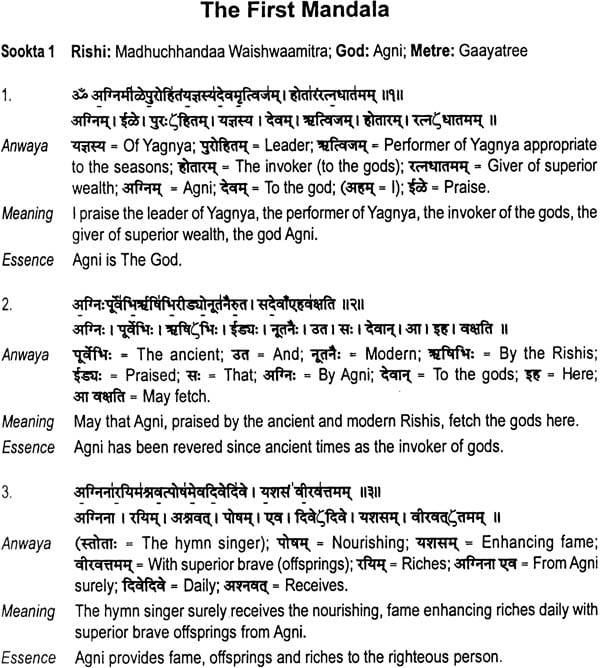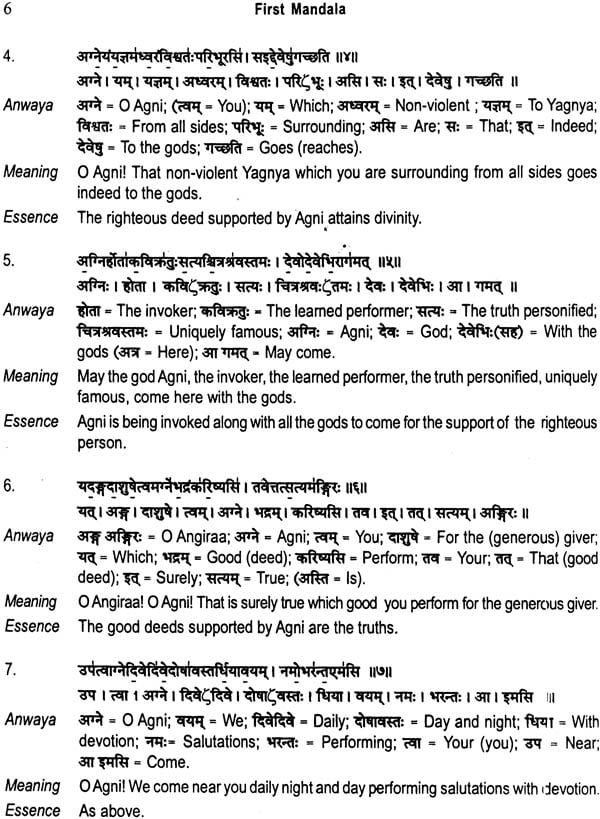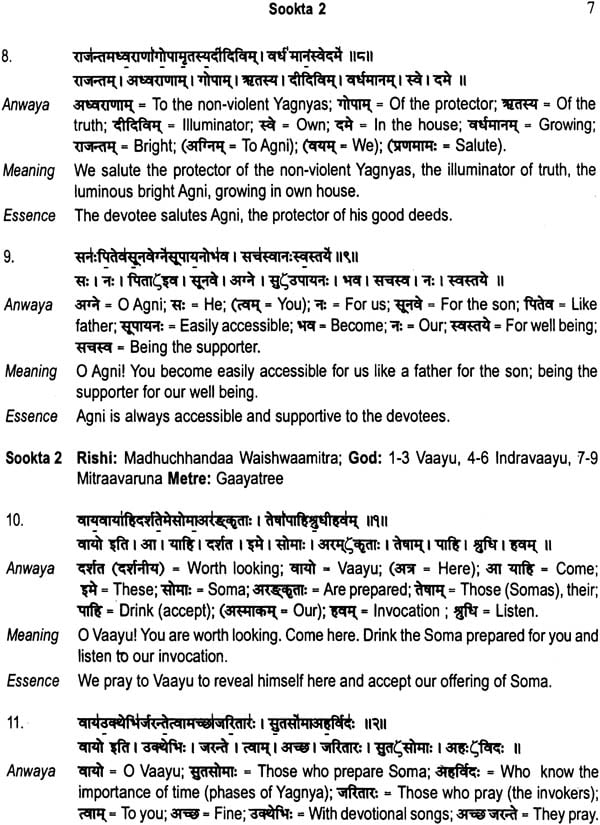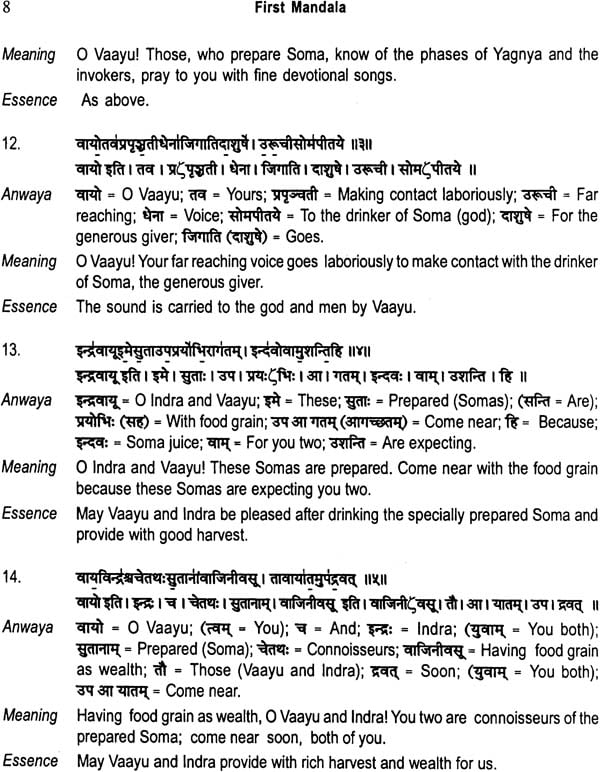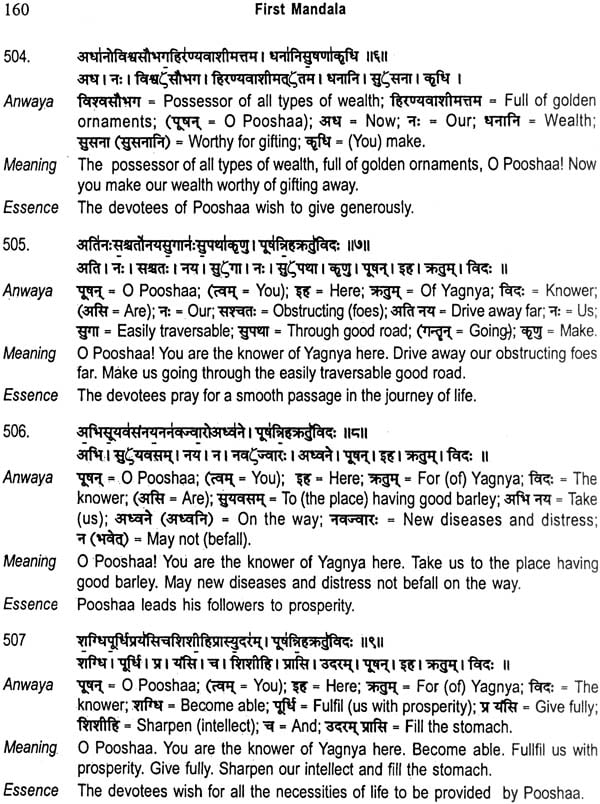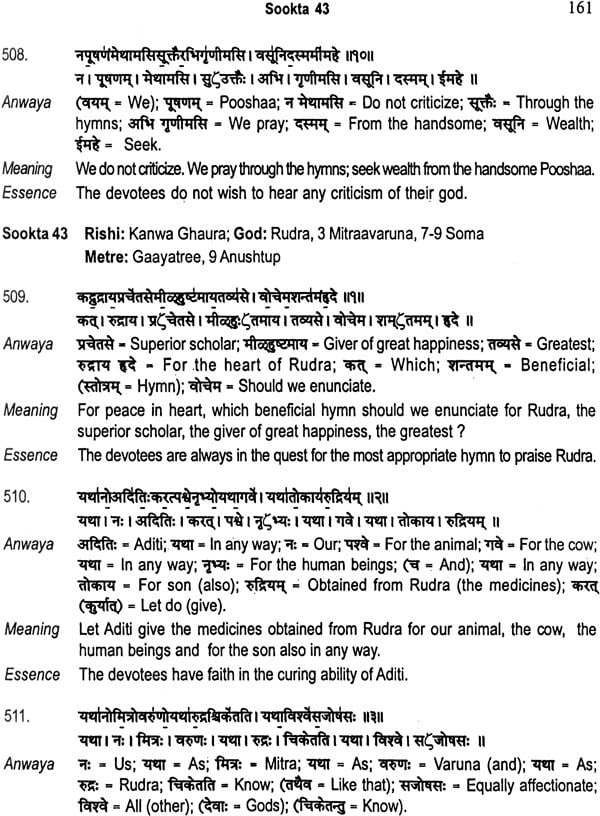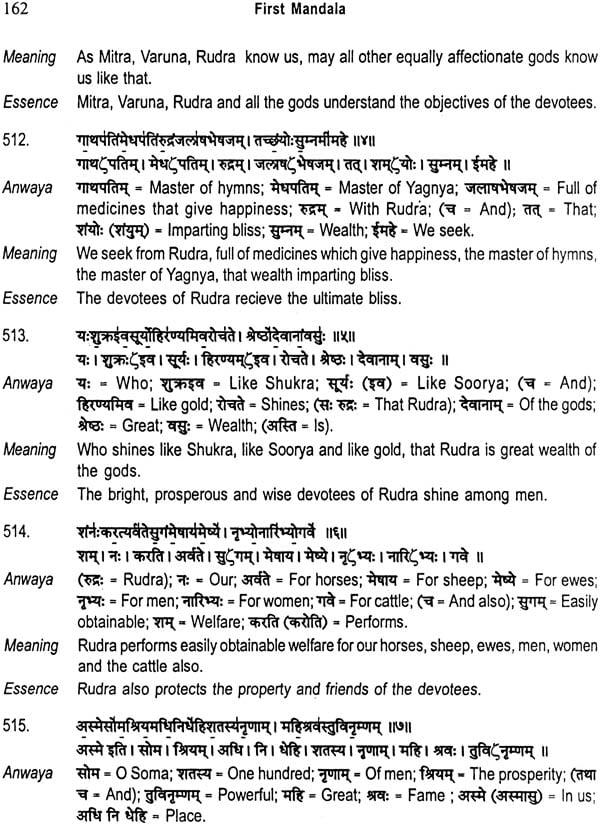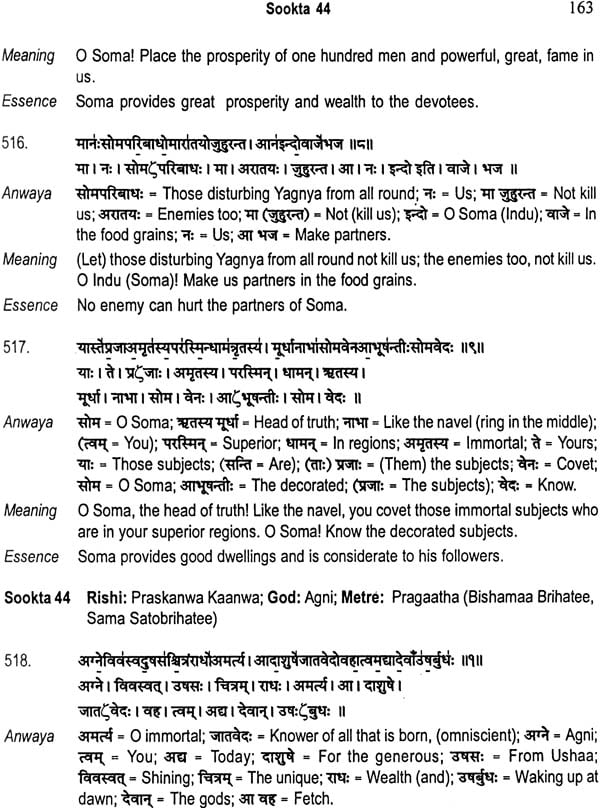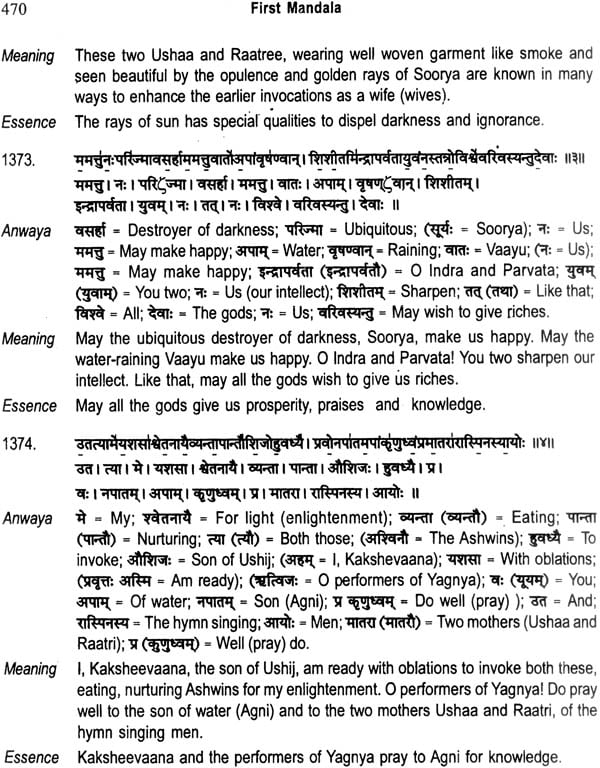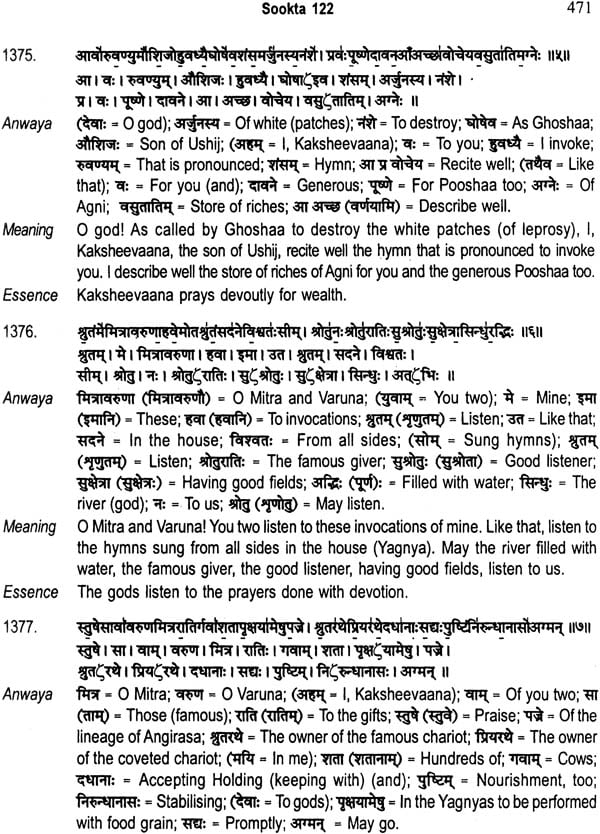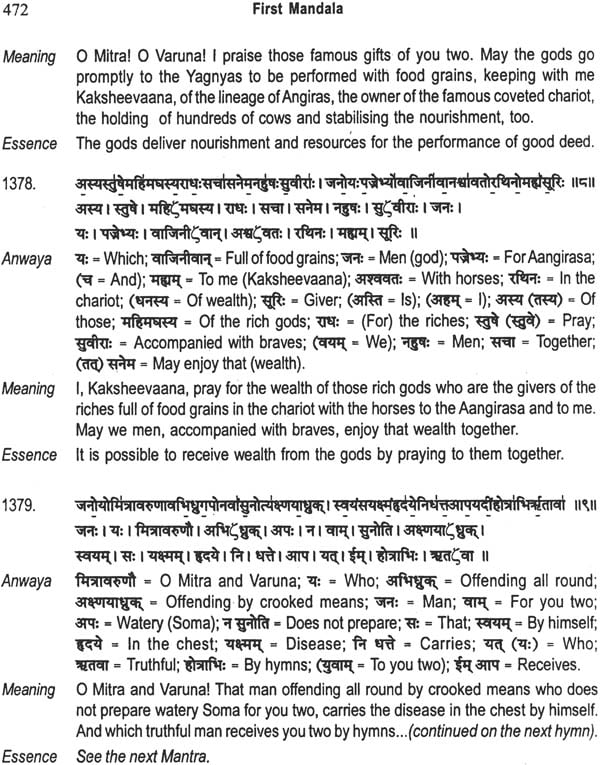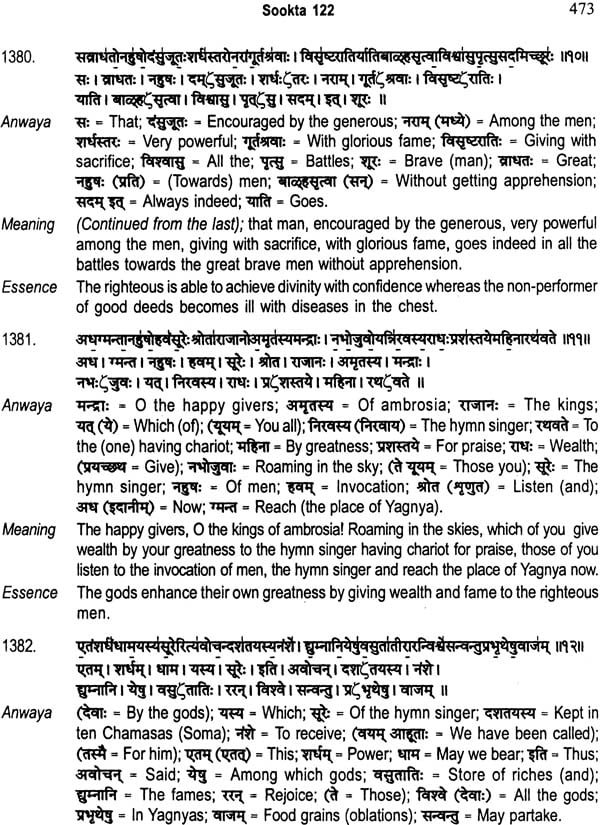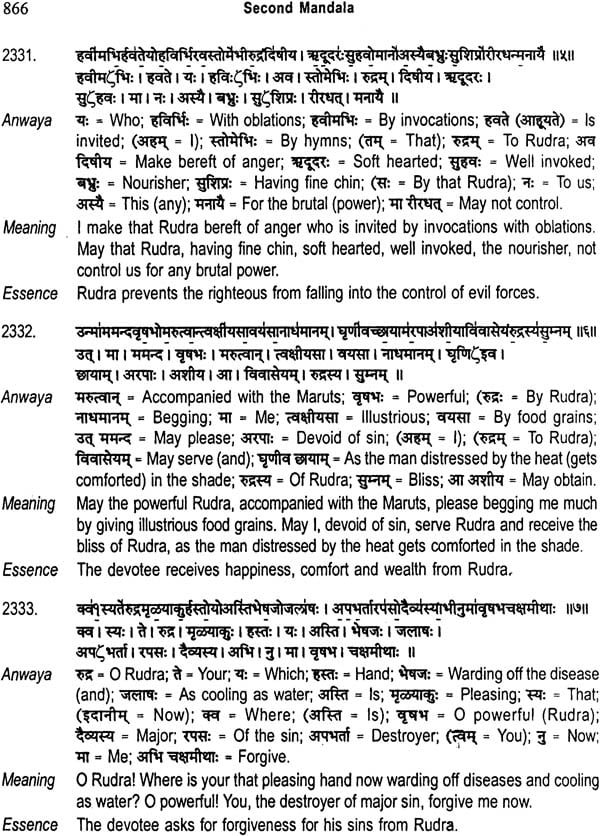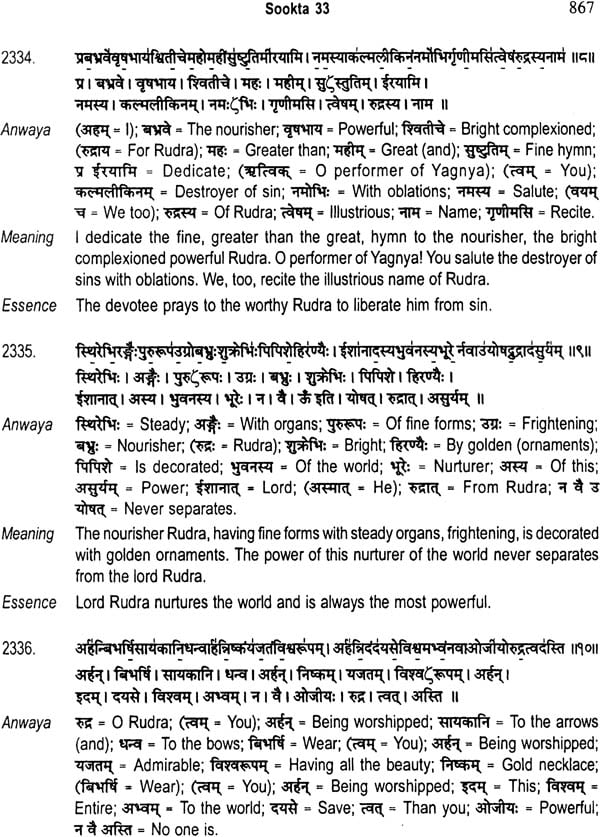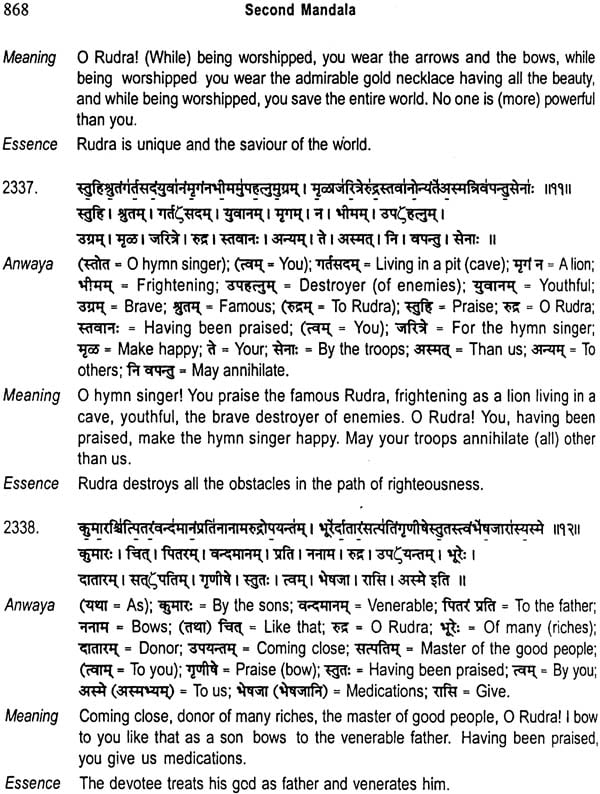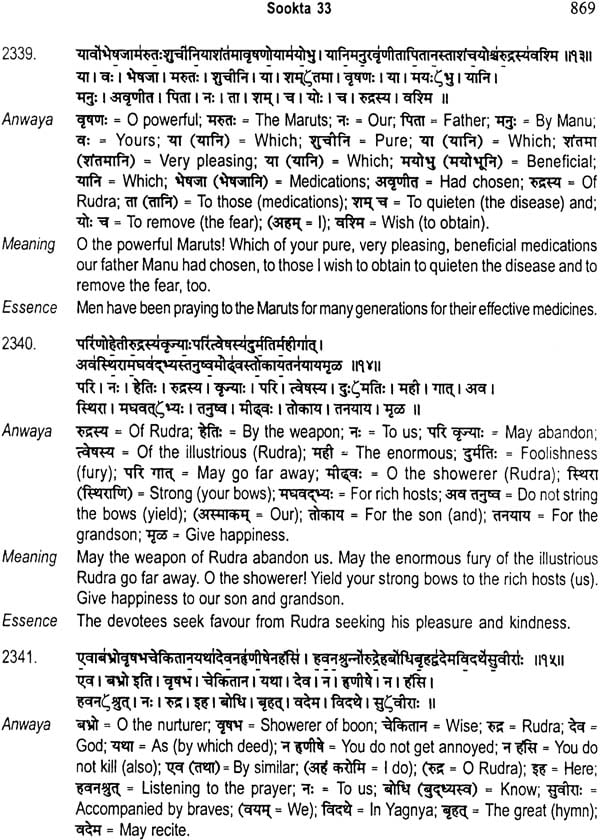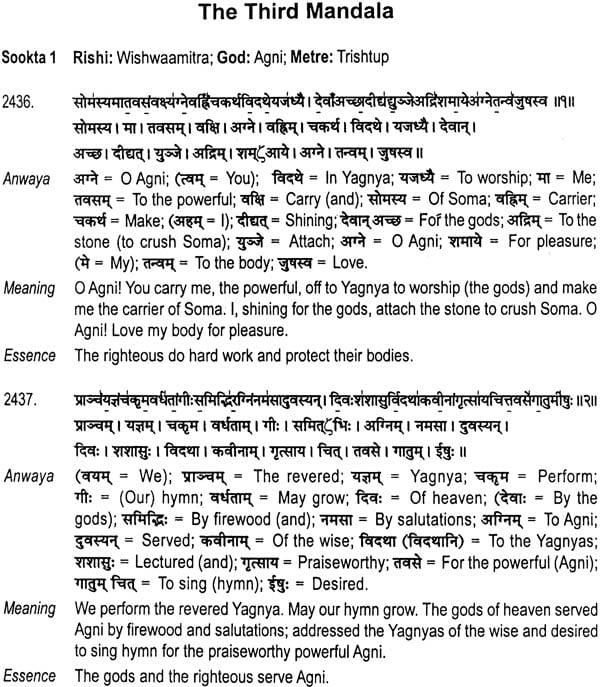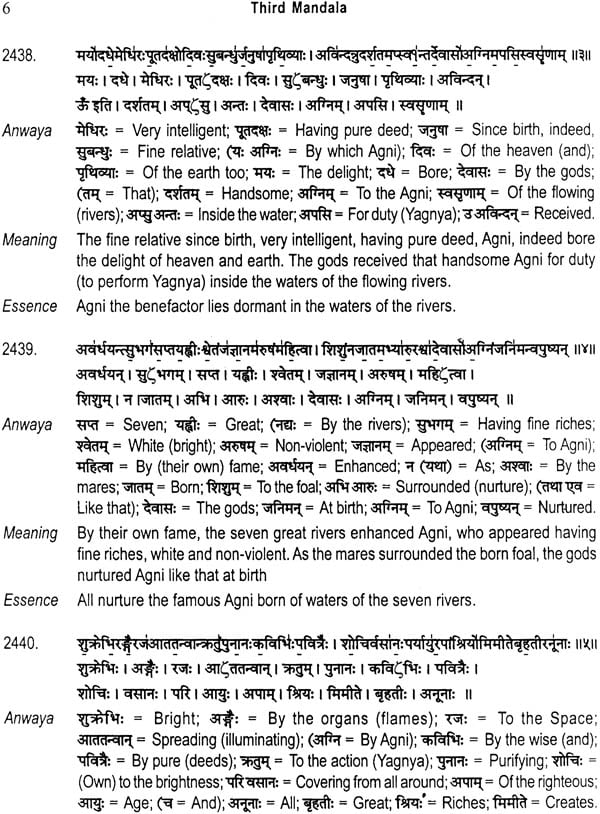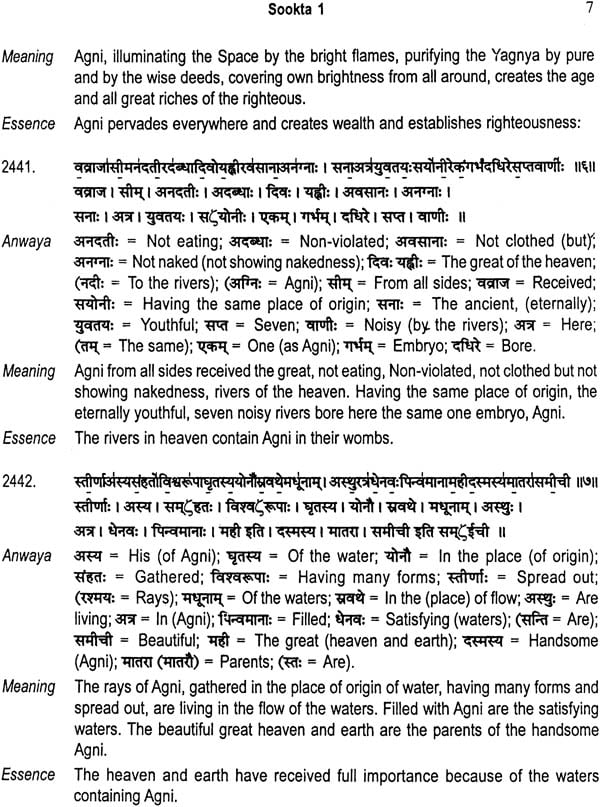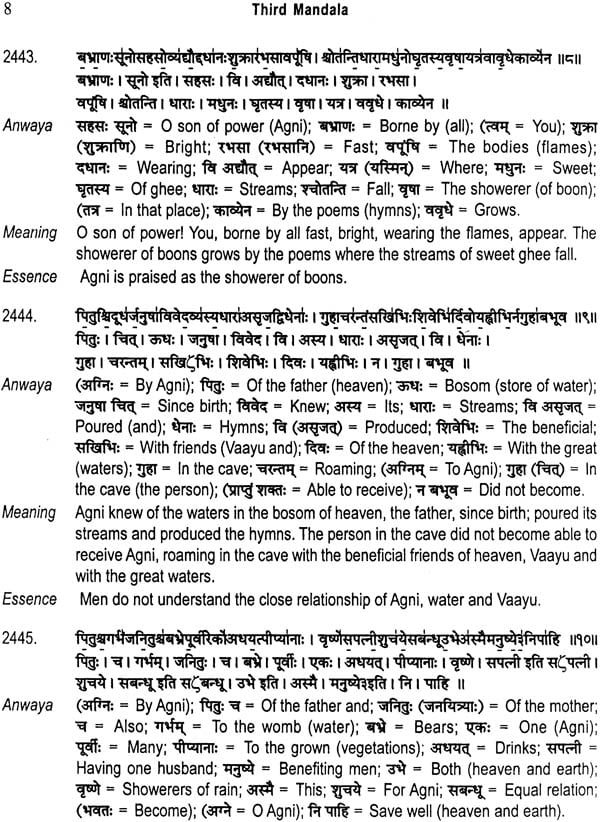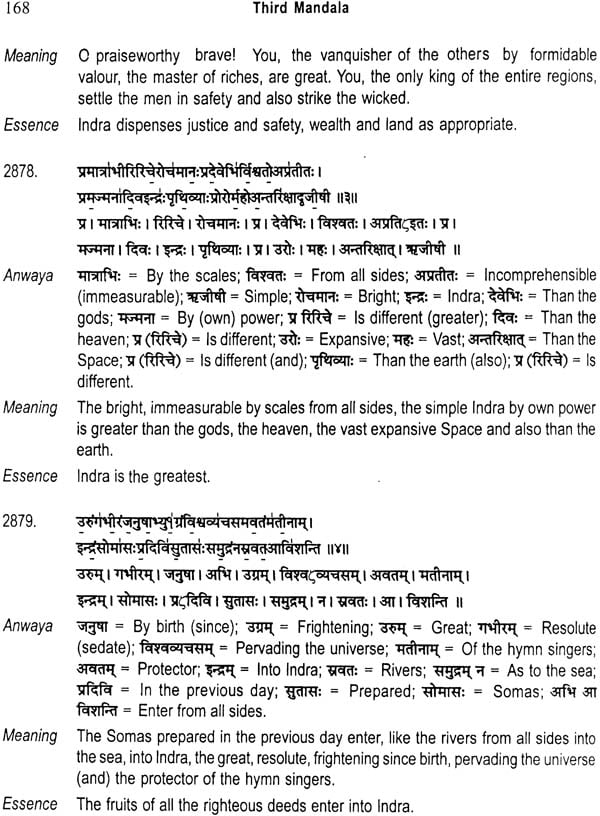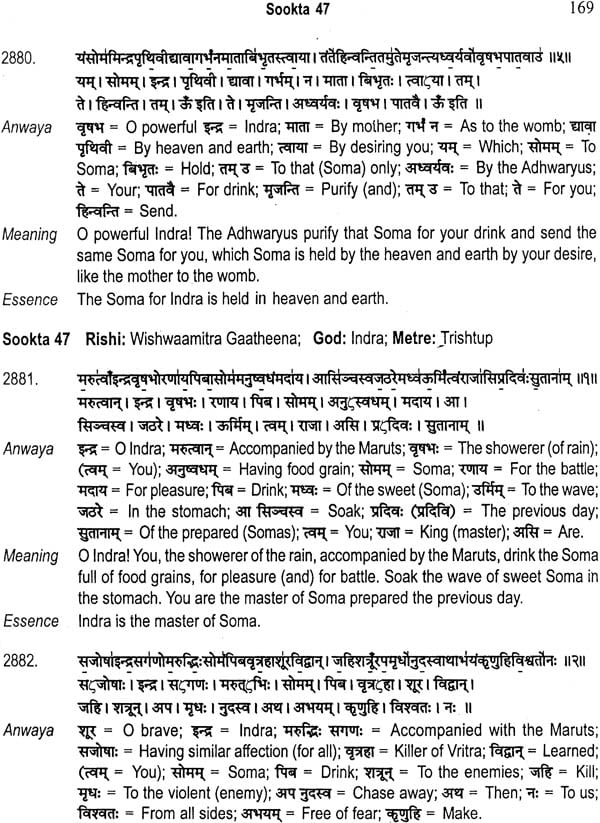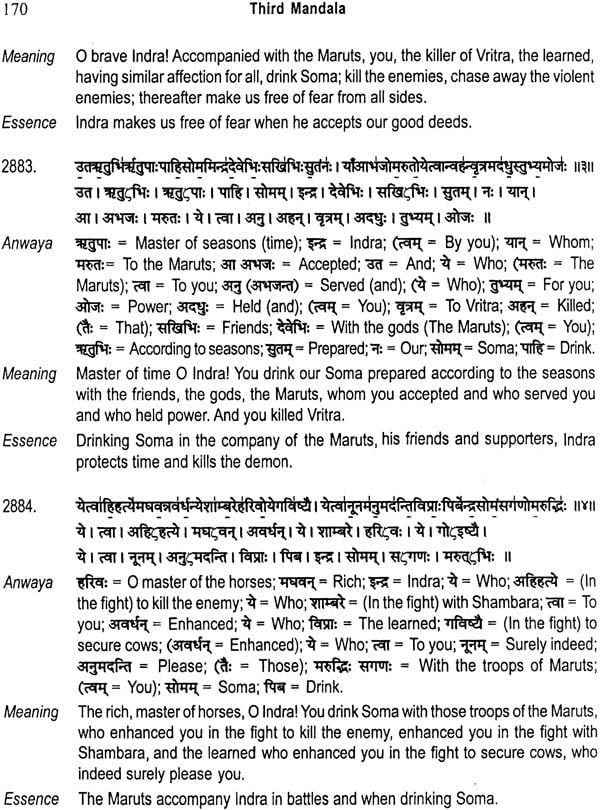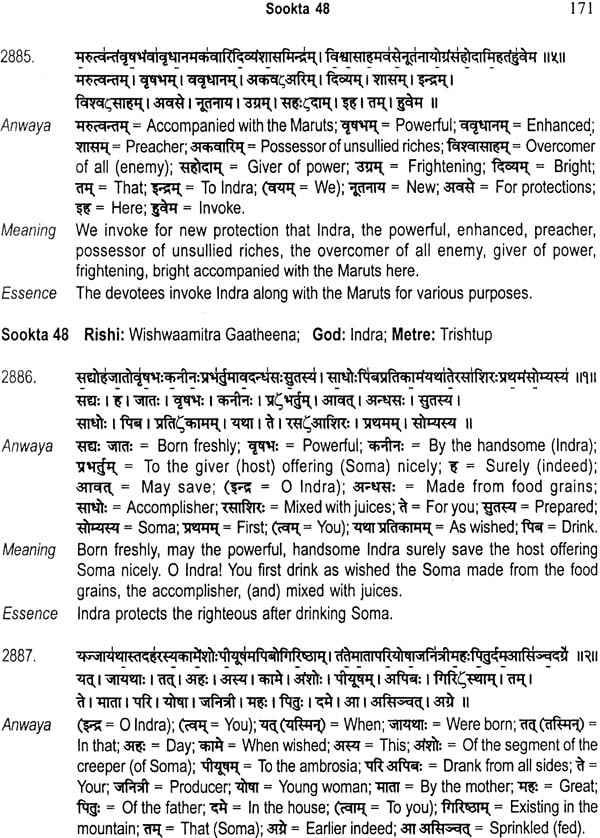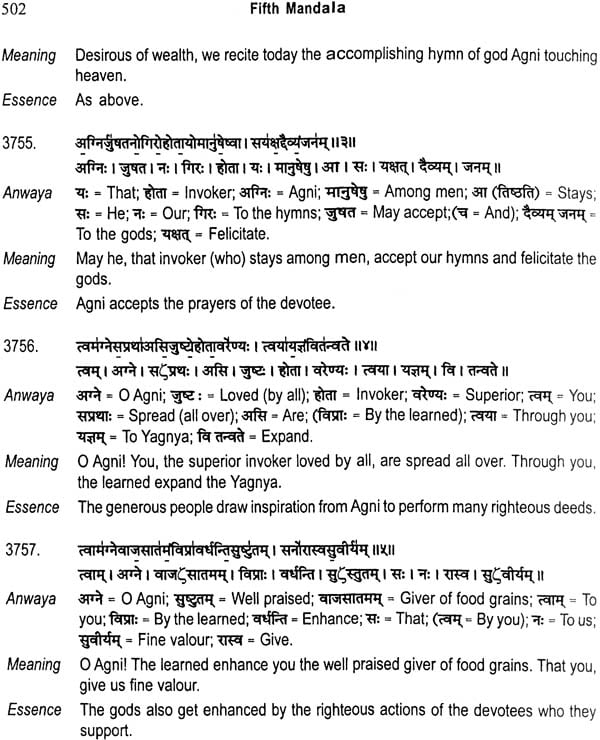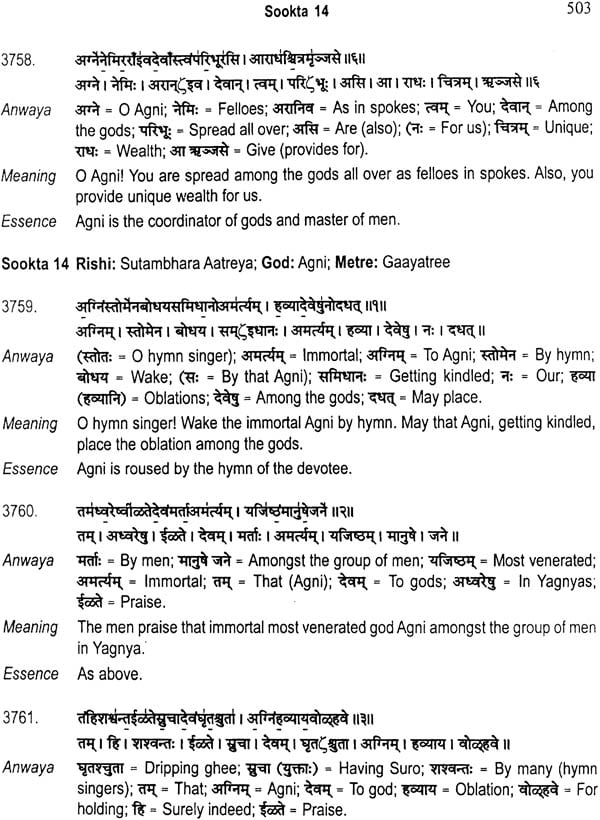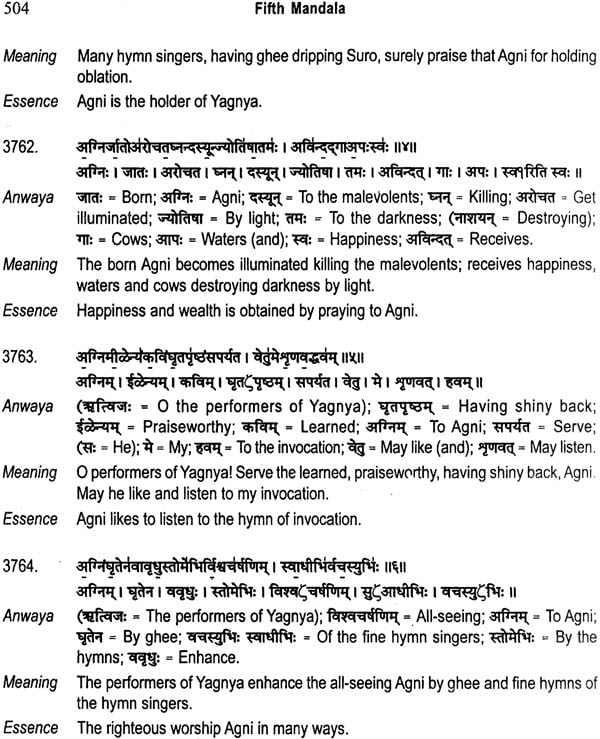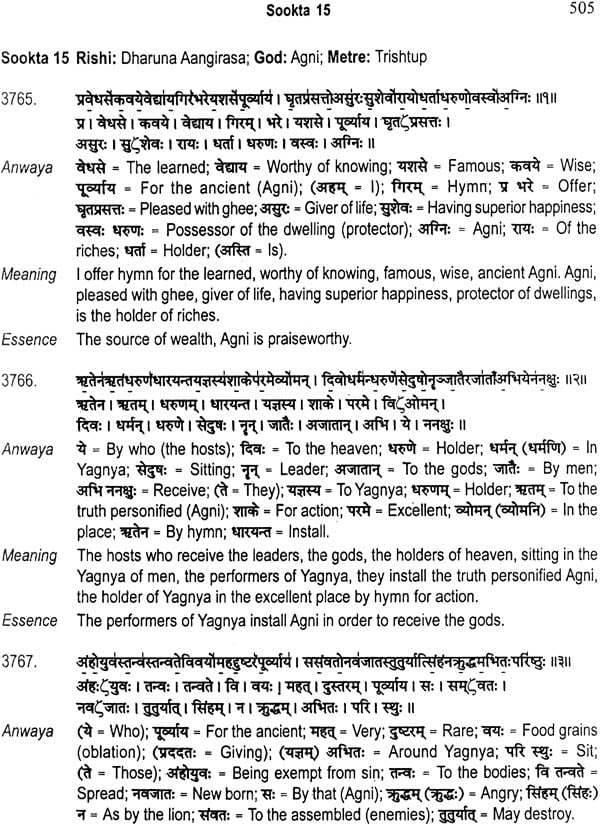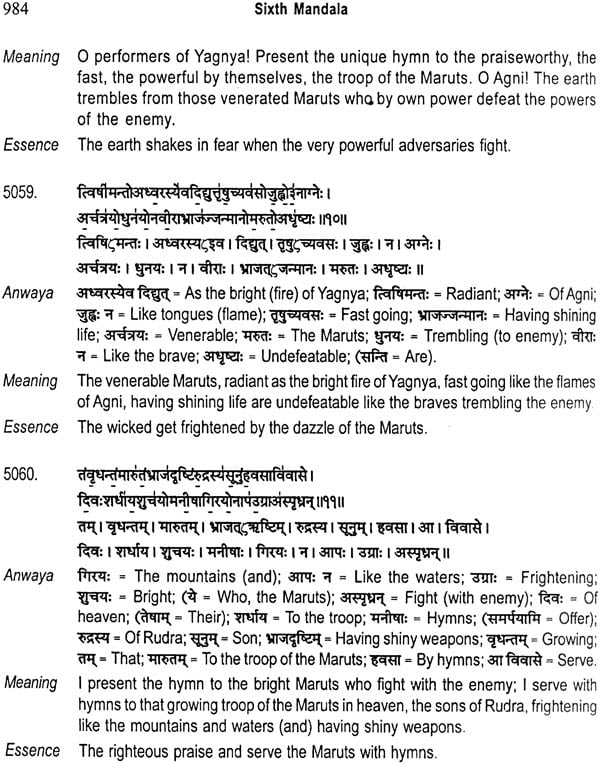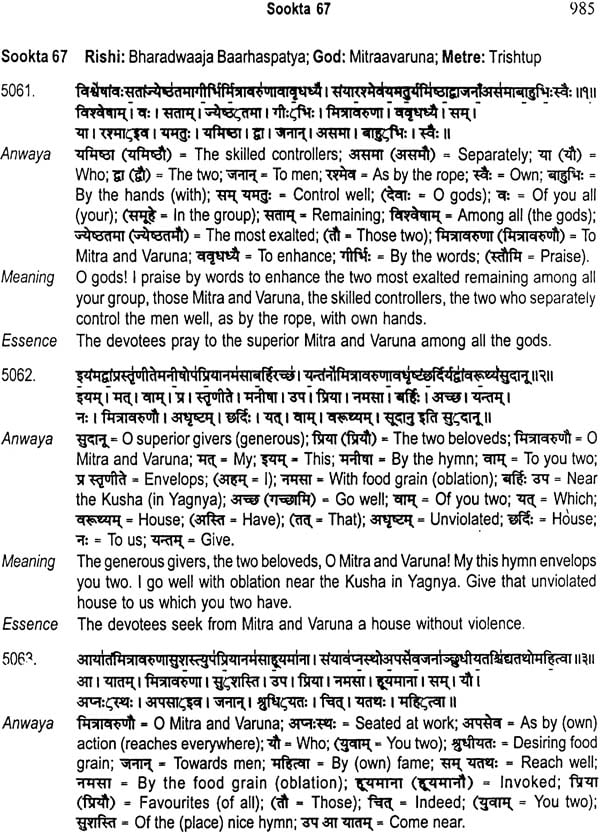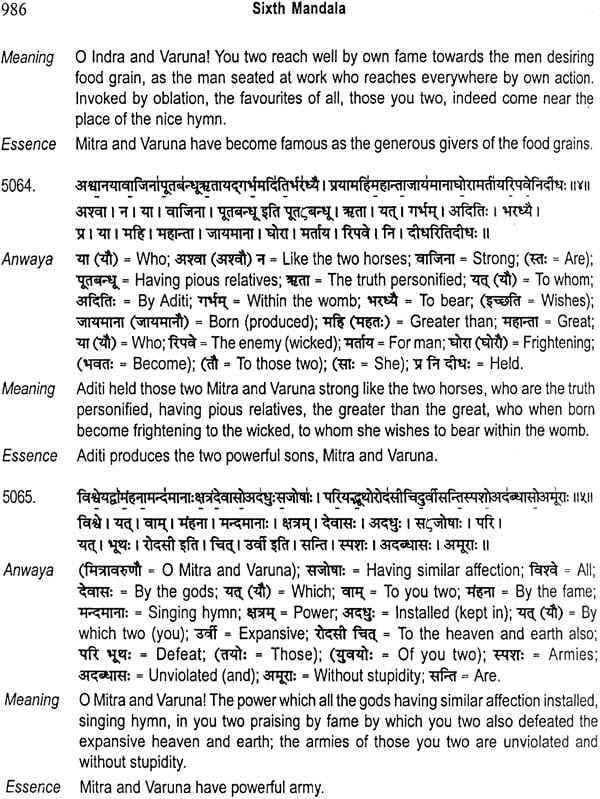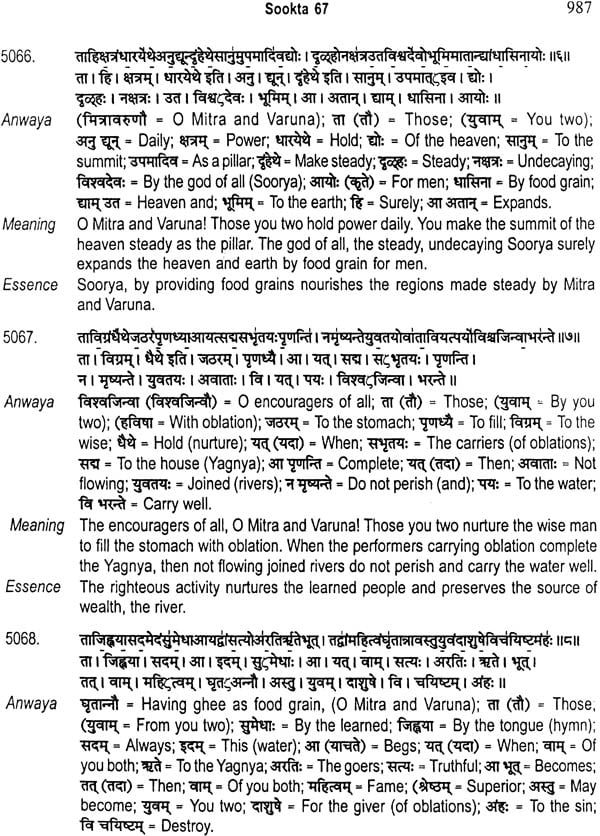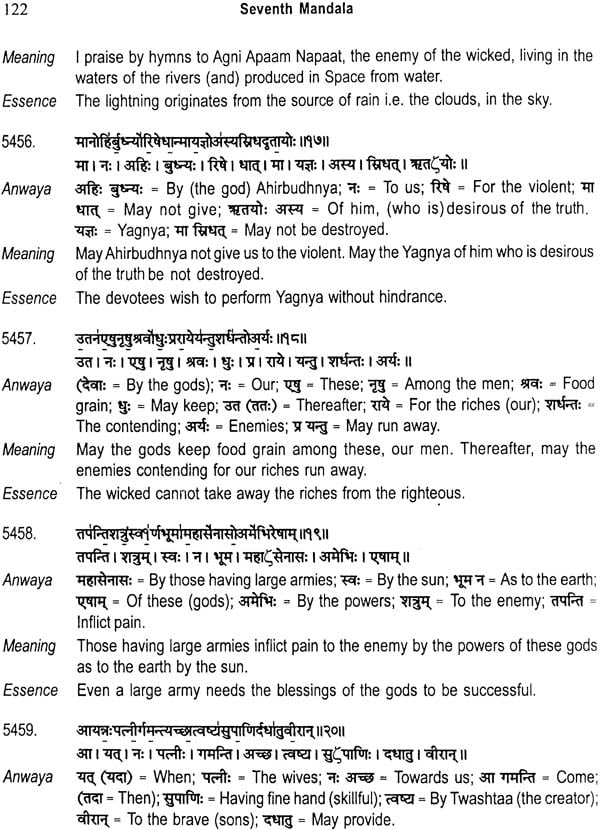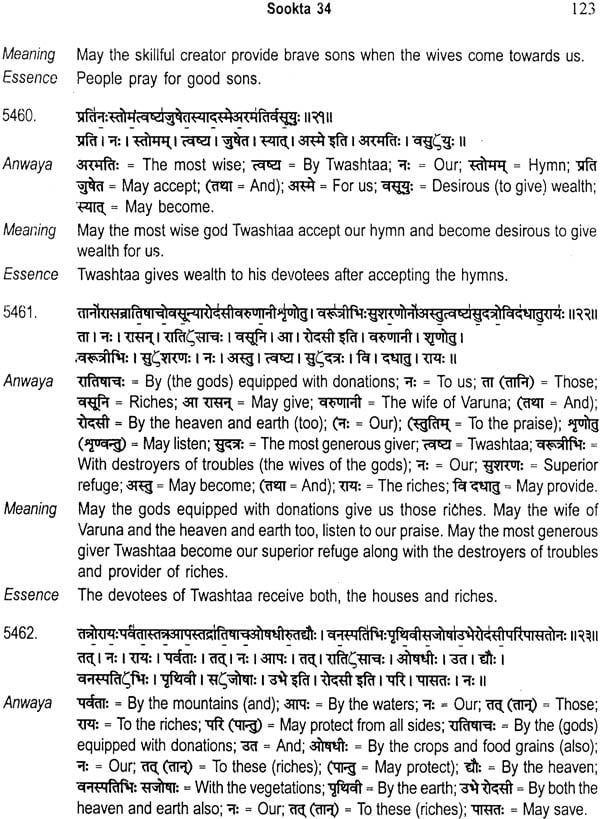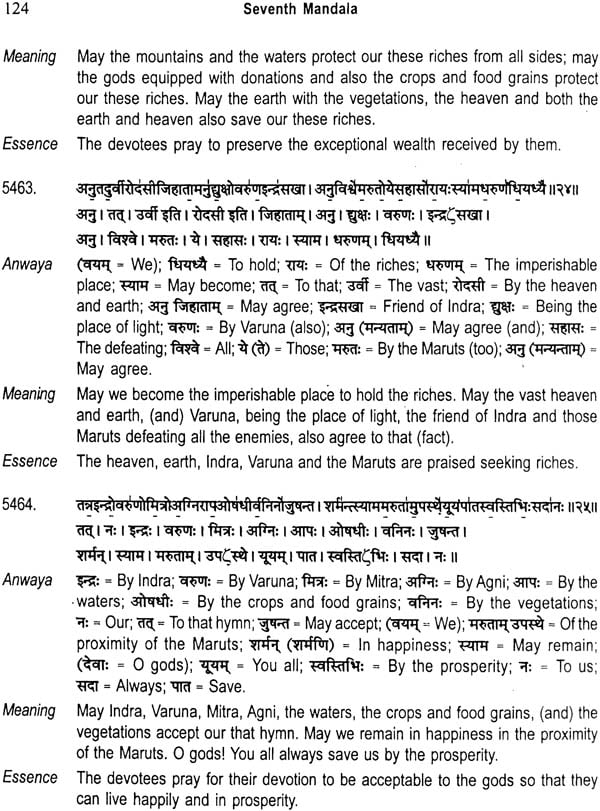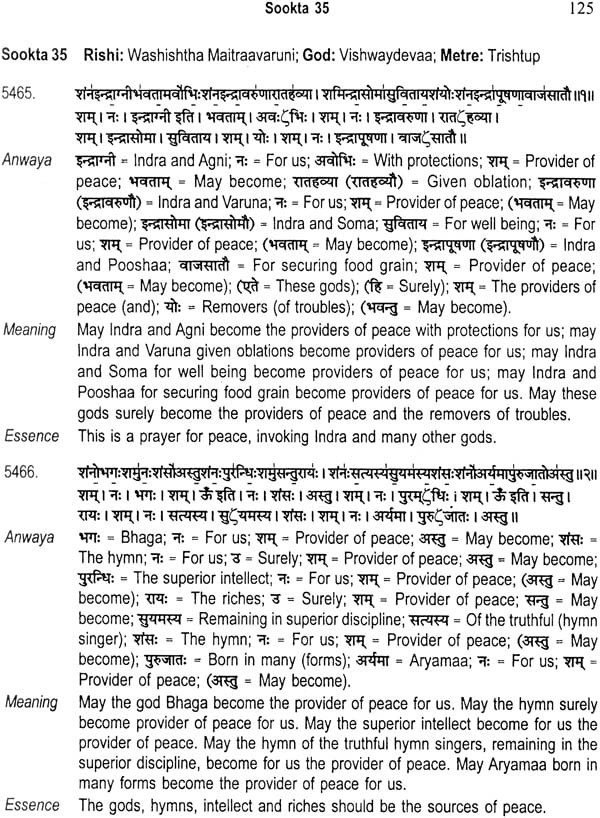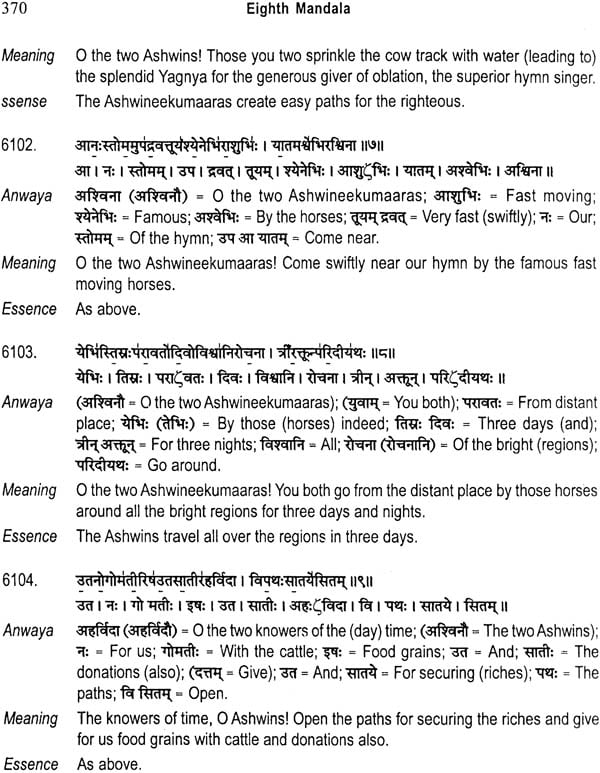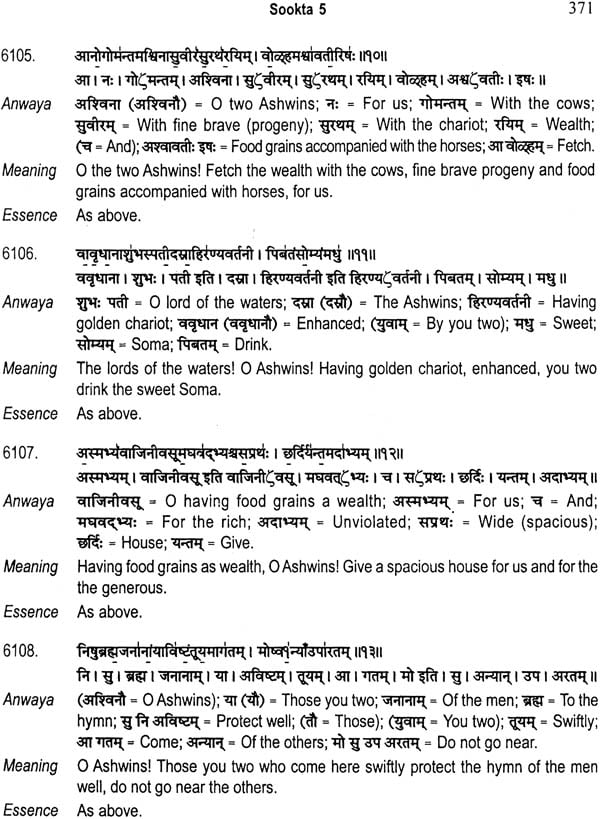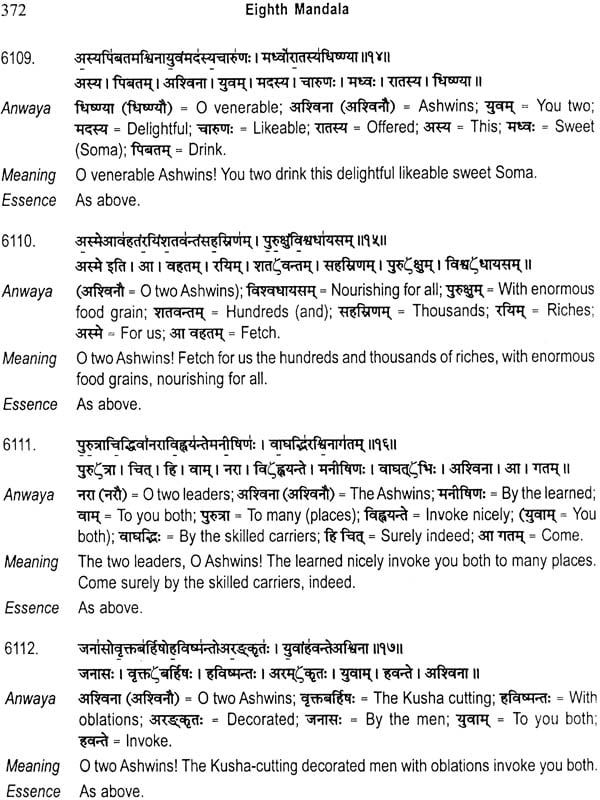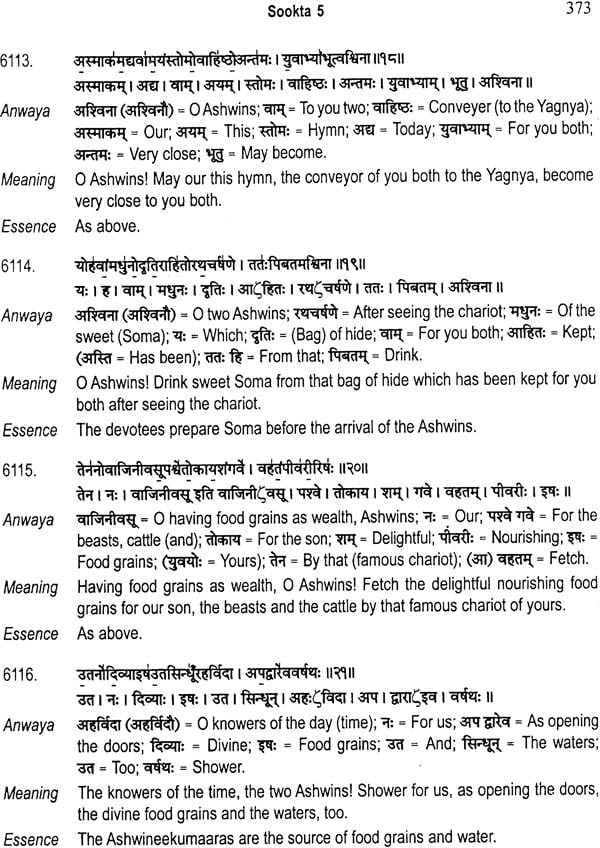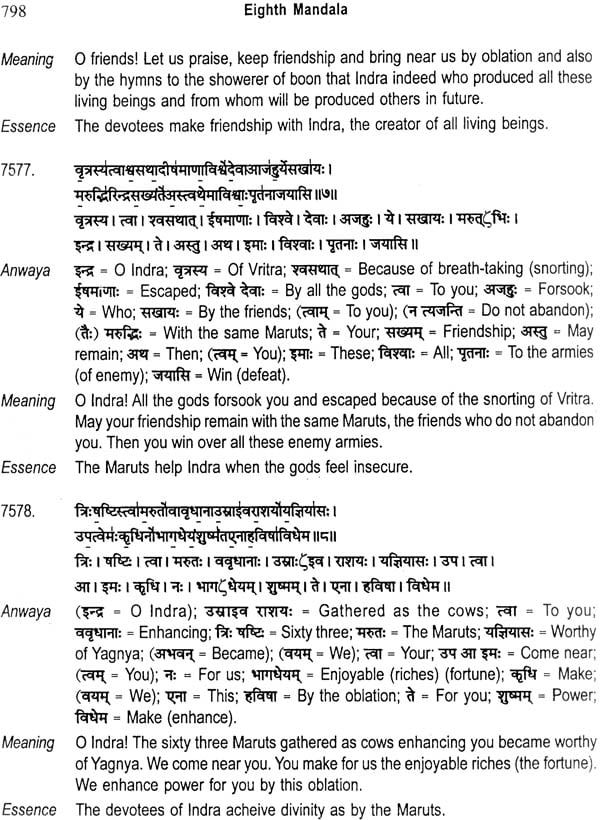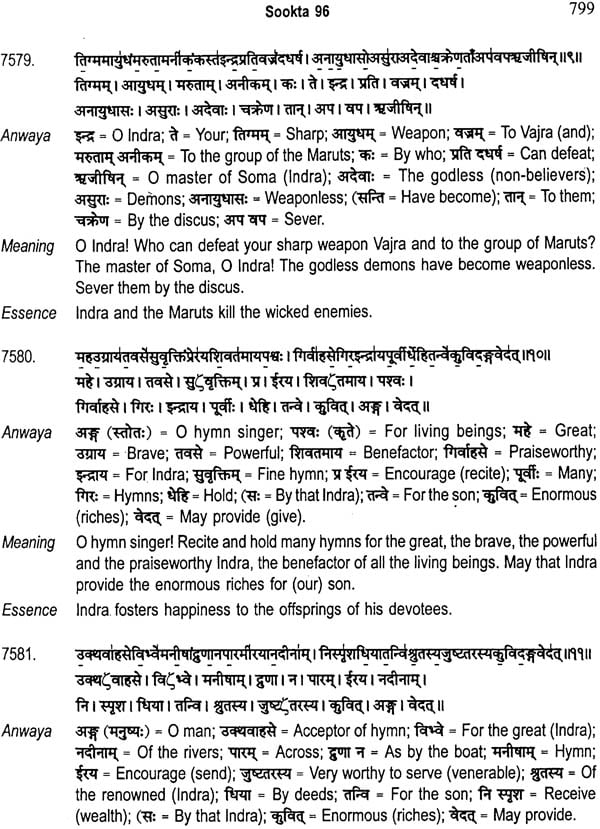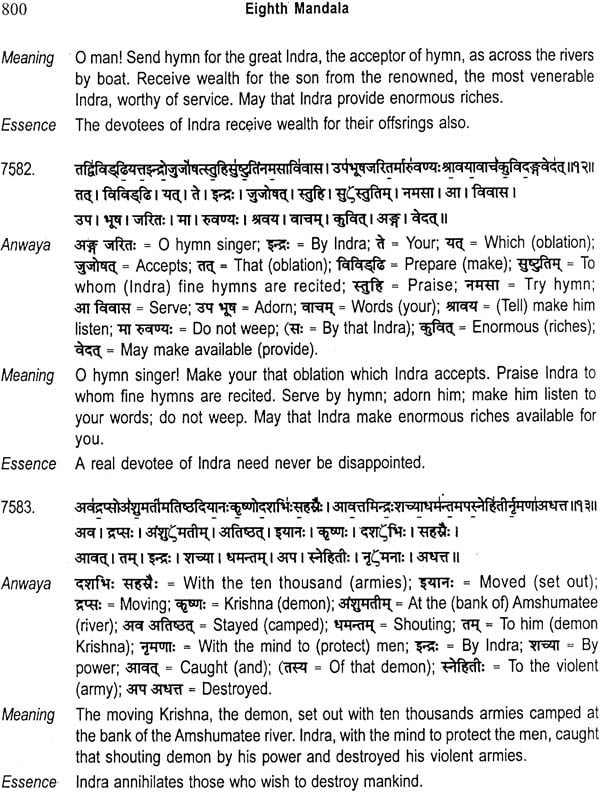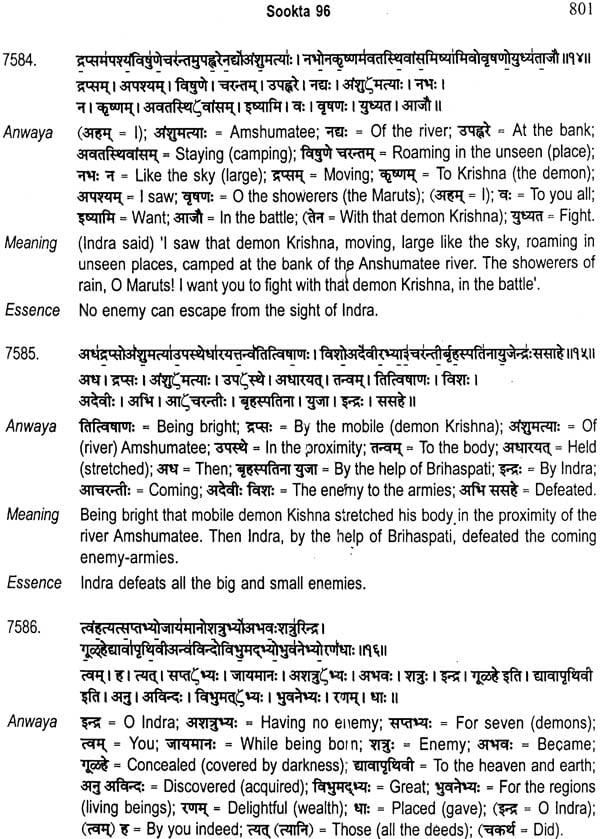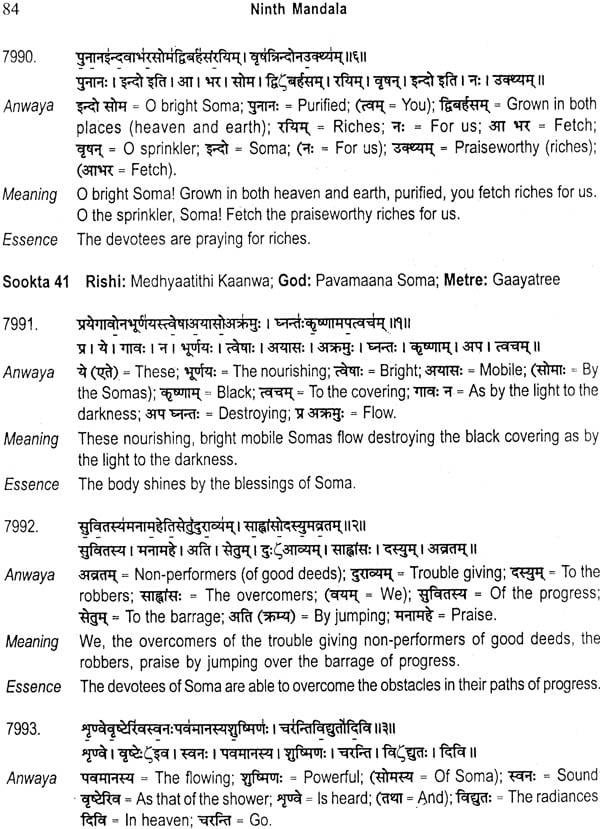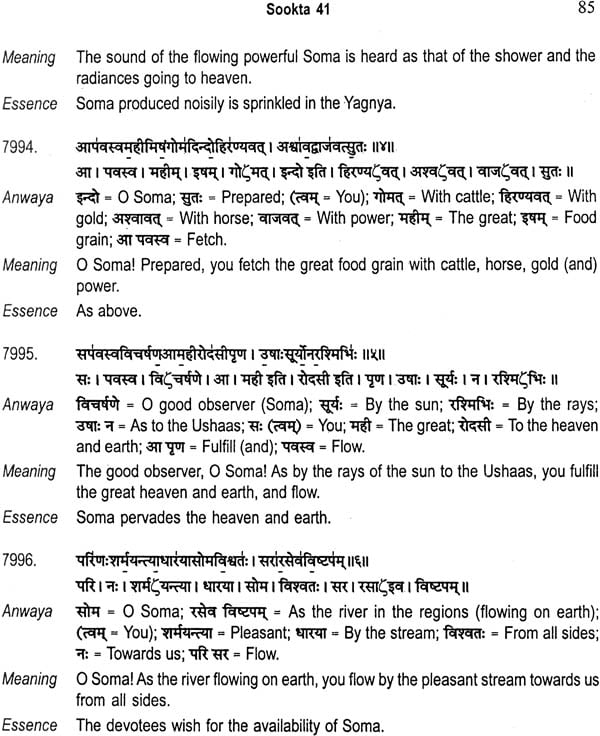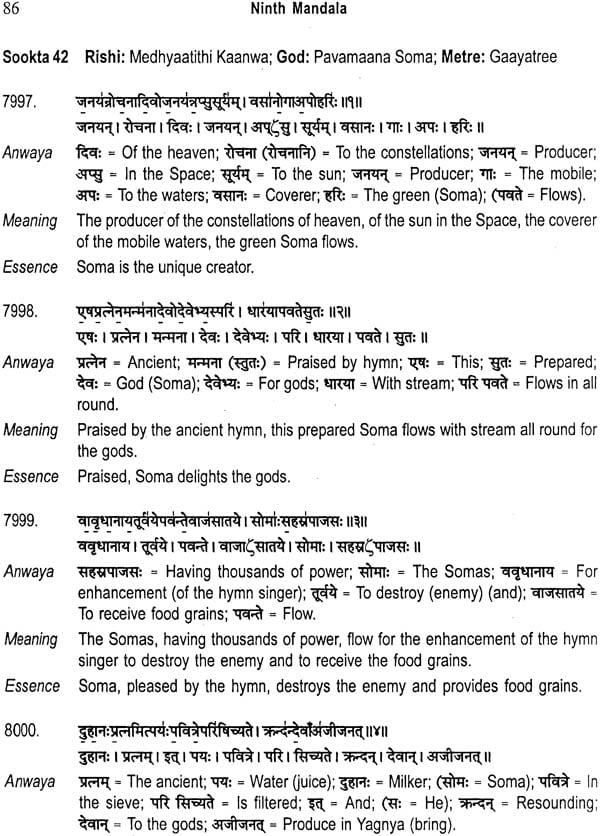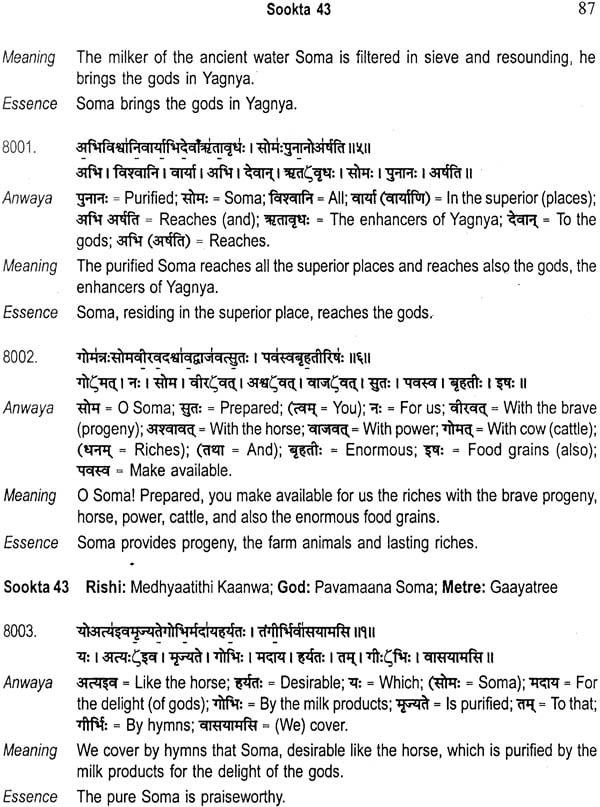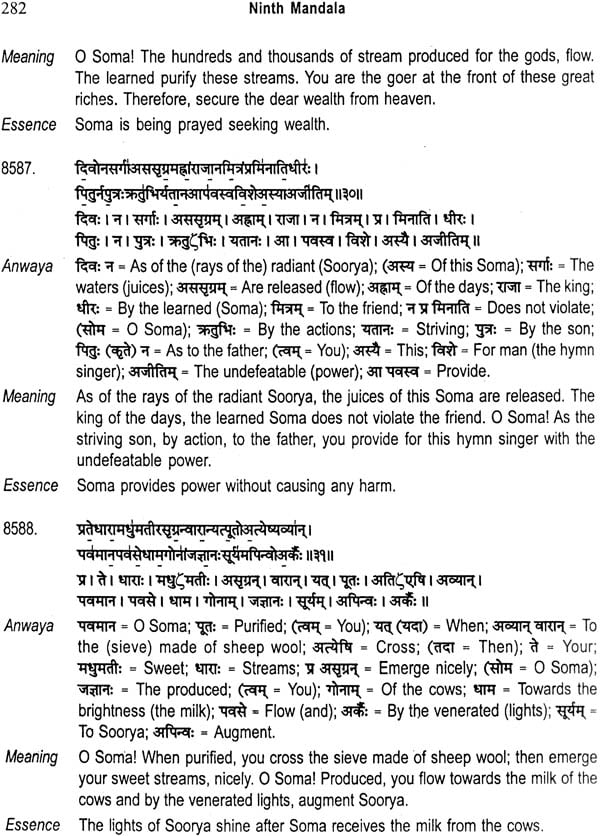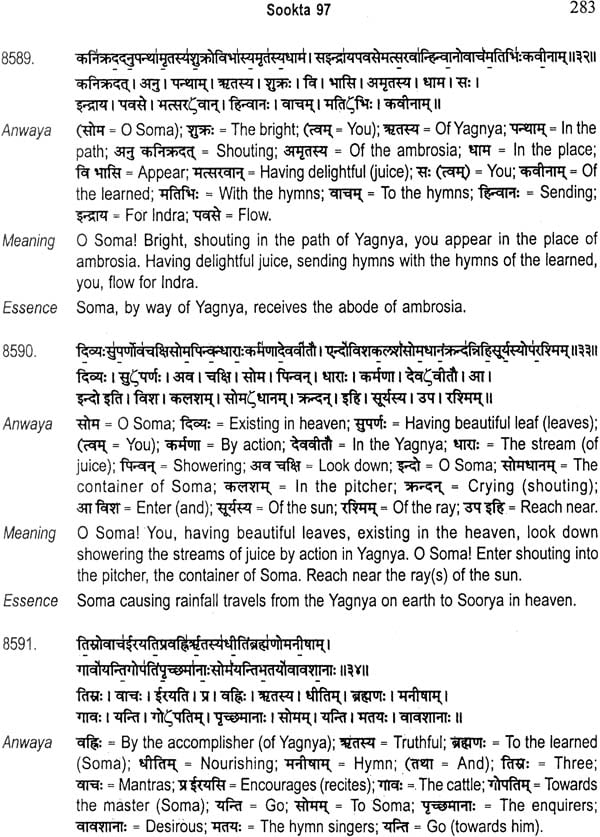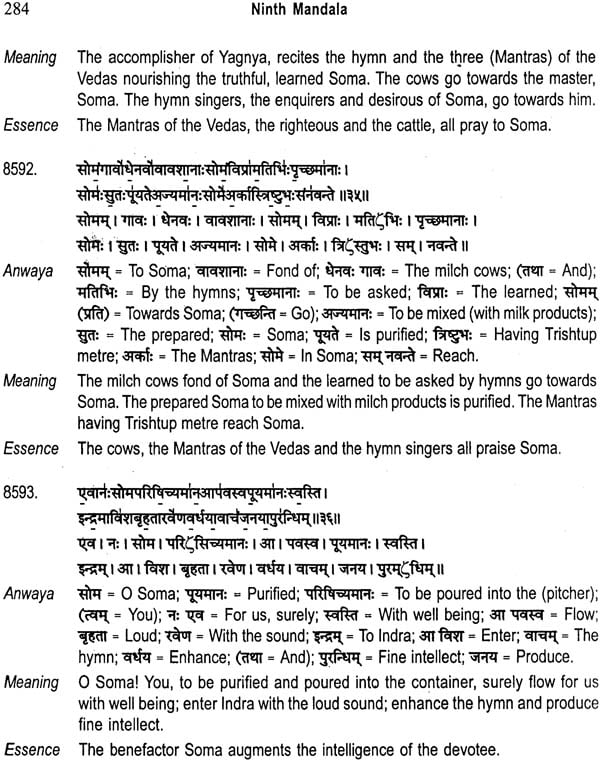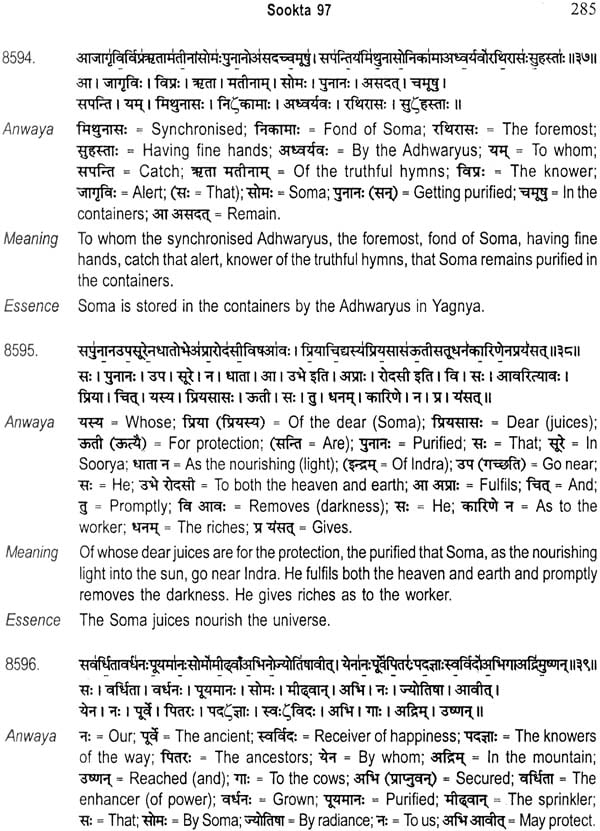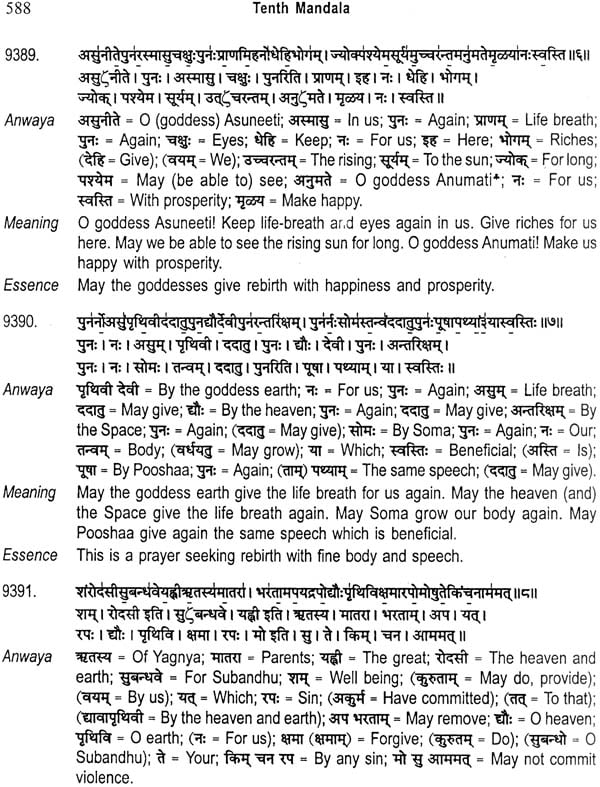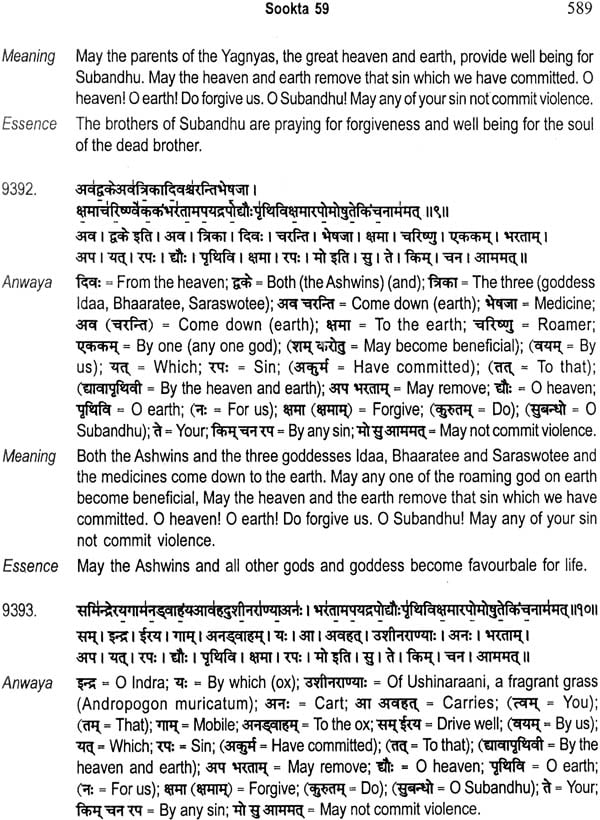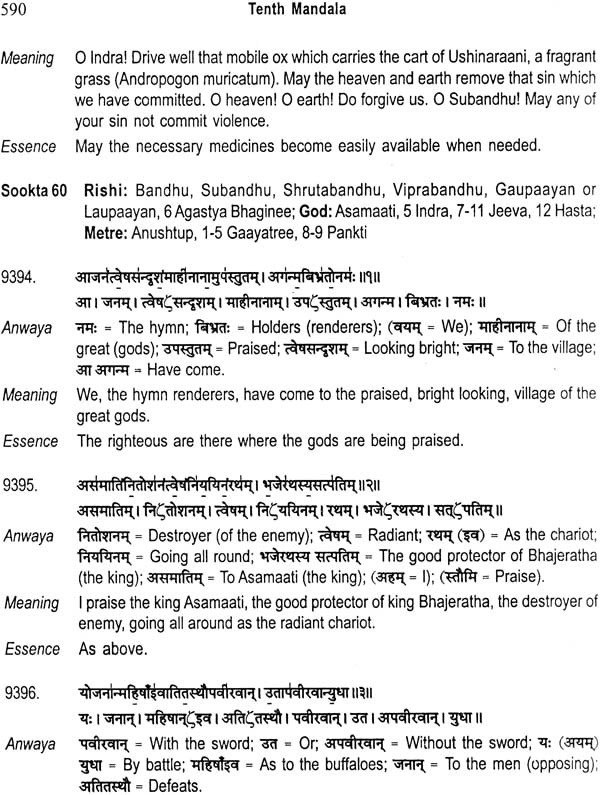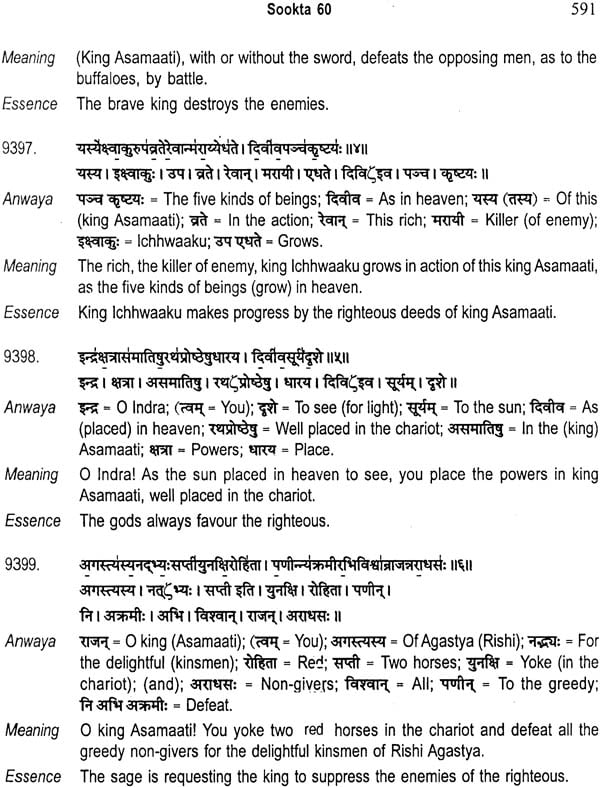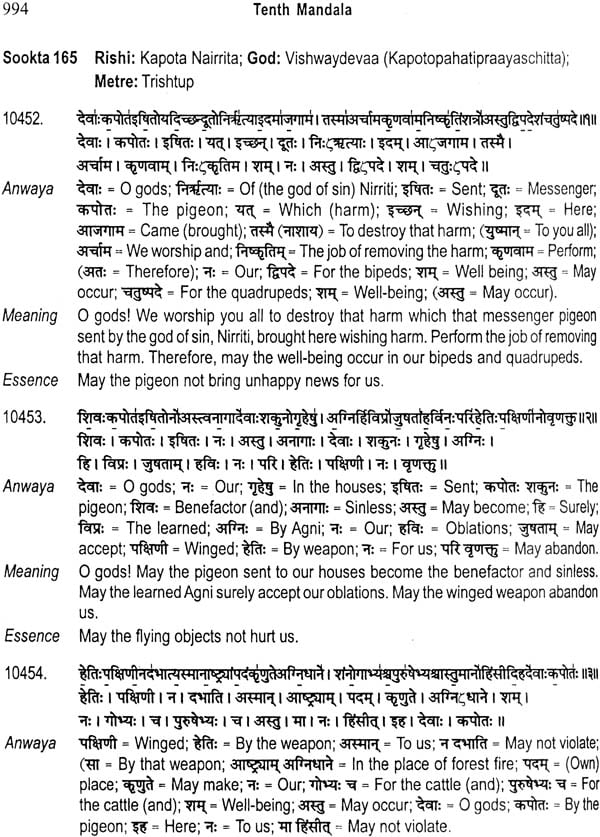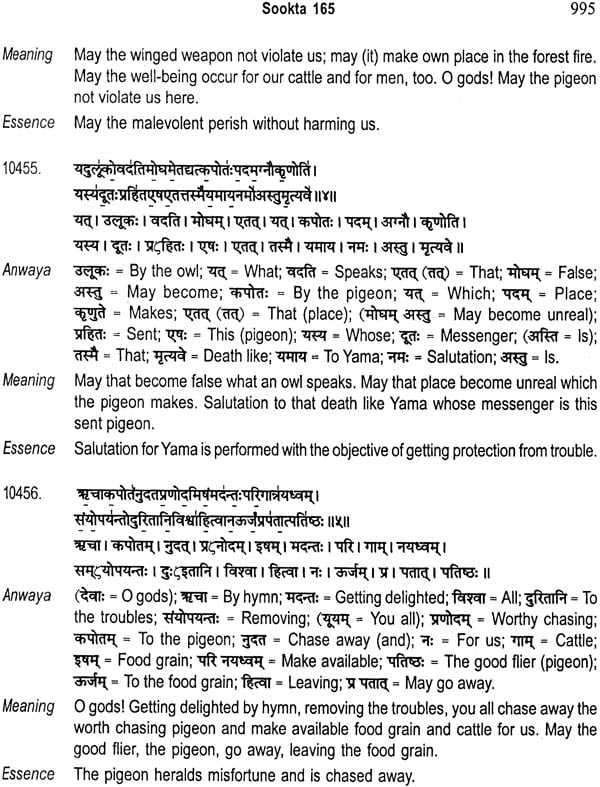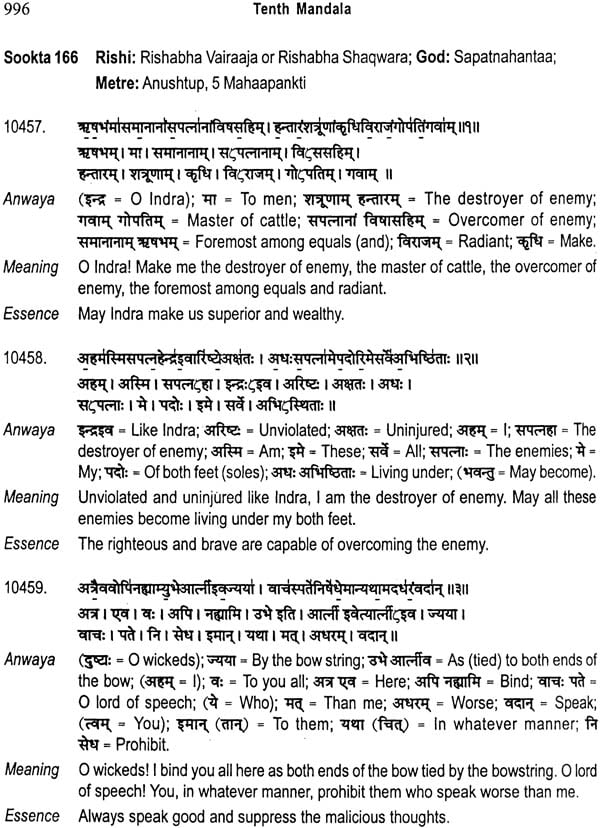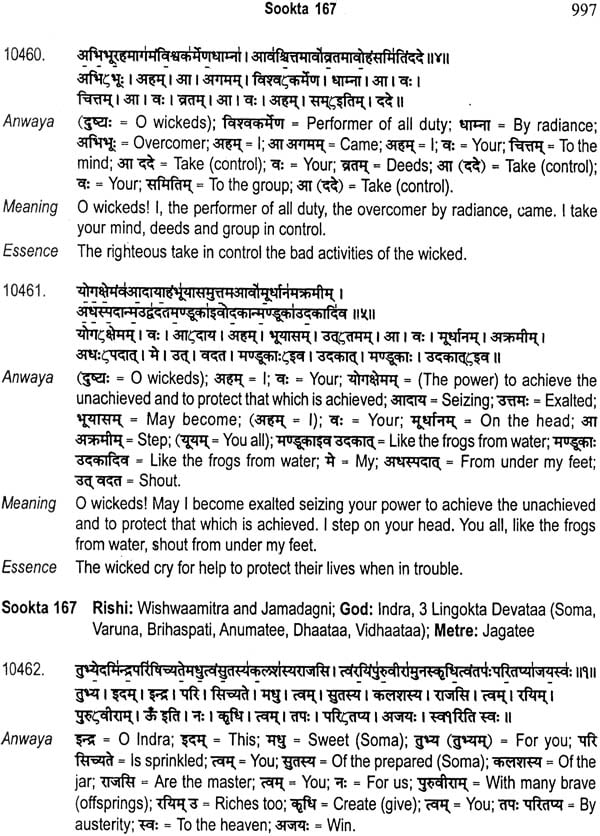
Modern English Translation of The Rig Veda Samhitaa (Set of 4 Volumes)
Book Specification
| Item Code: | NAJ474 |
| Author: | Prasanna Chandra Gautam |
| Publisher: | Bharatiya Vidya Bhavan |
| Language: | Sanskrit Text With Word to Word Meaning English Translation |
| Edition: | 2014 |
| ISBN: | VOL:1-9788172764944 VOL:2- 9788172765064 VOL-3- 9788172765163 VOL-4- 9788172765187 |
| Pages: | 3924 |
| Cover: | Paperback |
| Other Details | 9.5 inch X 7.5 inch |
| Weight | 7 kg |
Book Description
The Rig Veda Samhitaa, the most ancient document known to man, has been resurrected word for word in modern English. often emulating the original Mantras in style and presentation.
This is the first time the whole of the Rig Veda Samhitaa has been translated in English directly from the Sanskrit Mantras, with each Mantra having first been interpreted by a group of six scholars of distinction. According to the author there is no similar work, apart from St. James Bible, which has been translated in this manner. An authentic and unique translation, this work is surely a masterpiece. Espousing the source of the ancient knowledge and philosophy, this also makes an invaluable tool for research into the earlier Aryan civilisation.
A must for the scholars and the shelves of all the libraries, this book is a testament to Dr. Gautam's endeavour in search of the truth. The Rig Vedic Mantras need no longer remain in mystery and speculation.
Background
It all started when I was asked to read a few Mantras from the Rig Veda and also explain their meaning at a wedding in 2006. I agreed to do this but later found that the Mantras were extremely difficult to interpret correctly. At first, I attributed this difficulty to my limited knowledge of Sanskrit but soon realised that the formulae like nature of the Mantras, often without a verb, or noun or adjective or with superlatives of the adjectives with elliptical allegory and implications had caused this confusion. Therefore, I began to seek help from English and Hindi translations and commentaries. I became impressed by the scholarship of the translators but was unsure whether I or they had been able to comprehend the meaning intended by the1ieers who had composed the original hymns. All the works published thus far in English and Indian languages were not 'word for word' translations. The diversity of the commentaries and the far fetched claims of some of the leamed translators made the Rig Veda an enigma to me. Indeed, I could not find a translation that had been agreed as the most accurate by any two scholars. Many had felt the need for a modern and authoritative translation of the Rig Veda in English. All these facts roused my interest and prompted me to seek the truth of these Mantras which should, after all, mean the same for every one.
This led me to the study of the Rig Veda in a systematic manner. To begin with, I planned to get every word of the Mantras translated collectively in Nepali and English as faithfully as possible by a group of scholars with different expertise working together. The purport of the text would only be determined after all the scholars would agree to the meaning of every word in its appropriate context. This would need to be fully supported by all the available Sanskrit encyclopaedias and dictionaries, grammar, and relevant reference materials.
I did not need to conform to any dogmas or constraints in the pursuit of this project due to the fact that this was purely an academic exercise for which I was using my own resources. The experience of a life time of teaching and researching in medicine provided further guidance in the design and conduct of this project.
A team of scholars was formed under my leadership in Kathmandu, January 2008. A minimum of a Masters degree from a recognised Sanskrit university and experience of research, teaching and publications were essential to be short listed for the interviews in a nationwide search of suitable scholars. Some knowledge of English was desirable. Another essential criterion to be appointed was to be able to give full committment for the project, work unlimited hours as required and agree to search for the truth of the Mantras, irrespective of any peer pressure, the prevalent conventions and one's own bias.
Five scholars, namely Puma Chandra Dhungel, Tilak Prasad Luitel, Narayan Prasad Poudel,Hari Prasac'Kharaland Shyam Mani Nepal were appointed after formal interviews. All fulfilled the minimum qualification as above. All had good command in Sanskrit, Hindi and Nepali. Included in the team was Mr. Ram Sundar Humagain, a graduate student with exceptional skills in typing and computing. All were given resources to carry out independent and personal studies of the Vedas, particularly the Rig Veda for the initial three months and form an idea on how to conduct the massive task of translation within one year from the starting date. We began the collective work of simultaneously translating the Rik Mantras from Sanskrit into Nepali and English in April 2008 and completed the project in July 2009.
A small representative sample, including both Nepali and English sections, titled "Rig Veda: An outline of authentic translation: Examples from the first half" was published as a book (ISBN 978-9937 -2-1931-0) in December 2009 in Kathmandu after we had translated the first five thousand Mantras. This outlined the process and contained one hundred and thirteen translated Mantras selected at random from the first five thousand. The book was launched by the Chief Justice of the Supreme Court amidst two hundred eminent academics and literary figures in Kathmandu. This generated a great deal of positive feedback which helped us to improve our work. This also prevented any potential religious discontentment and provided the assurance that this was purely an academic enterprise without intending any religious offence or insult: Nepal has more than eighty percent of her twenty eight million populations as Hindus.
The Nepali version (Rig Veda Samhitaa Nepalima; 3463 pages in two large volumes) was published in December, 2010 at Kathmandu. This was launched and dedicated to the nation by Dr. Ram Varan Yadav, the first President of the Republic of Nepal.
It became clear during the revision of the manuscript in English that it would be desirable to seek constructive suggestions from a wide readership from Nepal and abroad to incorporate in the final draft. Hence a small book called 'An Introduction to the modern English Translation of Rig Veda Samhitaa with Mantra, Pada Patha, Anwaya, Meaning and Essence' (ISBN 978-9937 -2-3240-1) was published in Kathmandu in March 2011. This sample of our work contained many exerpts from the main manuscript, including the factual English translation of 332Sooktas. This generated many comments which we have gratefully incorporated in this manuscript.
Place of work
The work was carried out in Kathmandu, Nepal for a number of reasons, some of which are as follows.
• Kathmandu has a Sanskrit University and has produced some of the finest scholars in Sanskrit. Hence enthusiastic and brilliant scholars could be easily recruited who understood the work and gave their full commitment. In addition, expertise on various aspects of the work was readily available locally among the faculty and outside.
• Nepali language being a close relative of the old Sanskrit has helped us to understand the implied meanings, innuendos, the quaint figures of speech, e.g. the use of third person plural to denote the first person singular, with the accompanying grammatical errors, so often seen in ancient Sanskrit texts, and specially in the Rig Veda.
• Extensive research was essential. Many ancient documents, both published and unpublished, were required for reference. Some of these rare-manuscripts are available only in Nepal; a few are in the Gautam family library.
• Great scholars of the Vedas in India have written extensively in Hindi which has the same Devanagari script as Sanskrit. These books were easily available in Kathmandu. All the translators also knew Hindi very well.
• Last but not least was the constraint of the resources, both human and financial. It would have been impossible to get a totally committed team like this in Aberdeen, Scotland within my budget.
It is a pleasant coincidence that the two great Mantras of the Rig Veda happened to have been given by the Rishis living by the bank' of the river Koshi which is in the eastern Nepal. Madhuchhandaa Waishwaamitra gave the first Mantra of the Rig Veda which introduces God to us. His father Wishwaamitra Gaathina, (Kaushika) is the presenter of the famous Gaayatree Mantra which exhorts us all to seek enlightenment.
Method of translation
• It was essential to study the words in the original Mantra in relation to each other, their origins (व्युत्पत्ति), the verb, the gender, the case (plural, dual or singular) and to determine how any two words corresponded to one another most appropriately and the context in which the Mantra was being recited. This process and the identification of the presenter of the Mantra helped to establish a logical sequence of all the words in Pada Paatha. We have provided this 'Anwaya' in Sanskrit after much research.
• The most appropriate meaning of every word was researched from all the available sources and agreed unanimously by all the six of us, based upon the meaning inherent within the Mantra, the context and the subject. The words were then arranged in appropriate sequence to form a sentence in Sanskrit. Sanskrit sentence thus visualised helped to express that meaning.
• The prepositions, the conjunctions and the prefixes in Sanskrit do not often match with English. In addition, the figures of speech, the comparisons, the examples do not correspond well with English. To quote the great philosopher and linguist Sri Aurobindo, " ... when we write in a recognised and conventional imagery 'Lakshmi and Saraswotee refuse to dwell under one roof', the European reader may need a note or a translation of the phrase in its plain unfigured thought, 'wealth and learning seldom go together', before he can understand, but every Indian already possess the sense of the phrase. But if another culture and religion had replaced the Puranic and the Braahminical and the old books and the Sanskrit language had ceased to be read and understood, this now familiar phrase would have been as meaningless in India as in Europe. Some infallible commentator or ingenious scholar might have been ~roving to our entire satisfaction that Lakshmi was the Dawn and Saraswotee, the night or that they were two irreconcilable chemical substances or one knows not what else."(Ref. 1) One can now see how the phrases like 'the, flying horse' or 'the chariot larger than the sky' have been taken literally to contort the real meaning. The Nepali language has many similar figures of speech.
• The meaning of every word is given in English. The translation of every word into Nepali was a unanimous and collective effort. This formed the basis of translation.
• The simultaneous translation of Sanskrit words in two and at times three languages, Nepali, Hindi and English, concurrently helped me enormously to comprehend the true meaning of the Mantras and seek the most appropriate equivalent words in English for translation.
• Every attempt was made to minimise the system of Adhyahaar (31~), i.e. the easy way out by planting a new word according to the wish of the translator, to deal with difficult and incomplete verses. Most of the words within the brackets indicate the difference in the current grammar and only rarely to construct a sentence.
• The sentence for 'Meaning' was constructed from within the words of Anwaya and given as a simple English text. Every attempt was made to emulate the original Mantra, and in so doing, some poetic license regarding English grammar had to be taken to avoid further complexity in the composition. This literal translation should prompt the readers to search for any deep and secret meaning intended by the Rishi.
• The core content of the Mantra was given as the Essence. The 'essence' was the collective opinion of the translators and meant for the curious general reader, although a serious researcher might also find this useful. The diverse background and expertise of the group of translators helped to determine this 'Essence' and avoid scholarly bias of any one individual. This 'Essence' ranged from a simple paraphrase to a different concept. No attempt was made to provide a learned commentary or explanation of the Mantra. We have frankly admitted that some Mantras, although translated, could not be properly understood. (e.g. 'Essence- Not clear')
• The diacritical marks in English letters were not used because this could confuse a reader who did not know Sanskrit. The words were spelt in English to produce as close phonetic resemblance to Sanskrit as possible with the original words in Devanagari script given side by side. The guide to the reader gives some examples of these words.
• A brief introduction to each Mandala was given at the beginning to inform the reader of the various subject matters inherent within the Sooktas. These introductions were intended to provide the barest outline of the contents within the Mandala and to give some background information, collated from other sources also, about the Rishis who presented the Mantras.
The format is thus designed to be of interest across a wide readership-the English speaking Sanskrit scholars, the researchers and those who have no knowledge of Sanskrit but wish have to read the Rig Veda out of general interest. The students of the Rig Veda, Sanskrit literature, philosophy, sociology and the ancient Aaryan history may find this translation particularly helpful. The purpose is to assist the reader to learn from the Mantras and contemplate on them. The Bibliography provides useful reference for further study and research.
Special features
• This is intended to be an extensively researched reference book on the Rig Veda in English.
• This is a word for word translation so as to enable the learned readers to contemplate the meaning of the Mantras themselves. This is intended to prevent peer pressure in the interpretation. This should facilitate further research in the Rig Veda.
• Explanation of special terms of reference, guide to the readers, the Bibliography of relevant reference books with comments on their usefulness, the indexation of the Sooktas for the gods, an outline of a religious Yagnya and a short introduction of every Mandala are intended to help a general reader as well as the researcher. A brief introduction to the ancient Vedic literature has been included.
• 'Anwaya' has been painstakingly and scientifically done with accurate modern Sanskrit grammar. Hence the translation in any other language can now be easily done.
• The text is deliberately written in easy conversational modern English for the benefit of even those who may have difficulty with this language. We have had to take a little poetic license with English grammar during translation to achieve clarity of the meaning while attempting to preserve the original style of the Mantras.
Working simultaneously in three or four languages throughout has caused difficulty at times with syntax for which we hope to be forgiven by the scholarly English readers. However, since six scholars have unanimously agreed the translation to be true to the Vedic Mantras, we hope that this work will be taken seriously by the learned readership. A work of this magnitude will inevitably show many errors in printing and proof reading. Also, as with any translation, our work too will generate differing opinions. Your opinions will be gratefully received. तन्मे मन: शिवसंकल्पमस्तु
The period of the Vedic literature has been variously estimated to be from two hundred years BC to four thousand years BC. Besides the Vedic literature, several other developments have produced profound effects on the Aaryan civilisation and its literature in India during that time. The following paragraphs attempt to provide a basic and essential information for the reader which may help to explain many aspects of the Rig Veda. The scholars wishing to pursue further study are requested to refer to the books mentioned in the Bibliography.
The Vedas
Veda means knowledge in Sanskrit which is the language of the composition of these documents. There are four Vedas, namely the Rig Veda, the Yajur Veda, the Saama Veda and the Atharwa Veda. Worldwide, one billion Hindus hold these four Vedas as their source of faith and philosophy but these unique texts transcend all other comparatively young religions. The Rig Veda is the most ancient and undamaged literature available in the world today and therefore recognized by UNESCO as 'the heritage of human beings'. In the simplest term, the Vedas may be regarded as the anthology of the ancient Aaryan civilisation. These compositions go back in time when the Aaryan society was beginning to develop into complex systems. Primarily, the society was grouped into four classes of people: the learned (Braahmins), the warrior (Kshetriyas), the traders and craftsmen (Vaishyas) and the servers (Shoodras). This is still prevalent and is known as the Caste System in India and Nepal.
At first, there was no written record. All the verses were memorised and passed on from one generation of the Braahmins to the next. The Rishis were continuing to add on to the already existing mass of the Mantras. The Braahmins began to take the leading role in performing various ceremonials. They determined the correct way of recitation and utilisation of the Veda Mantras for many rituals. This led to the production of the 'Braahmana'. There were as many Braahmanas as the learned influential Braahmin priests. This system continued for a long time and the Braahmanas also began to acquire a very reverential status, like the Veda Mantras, among the common man.
Along with the development of the new Mantras, and the treatises as the Braahmanas, philosophical discussions began to be the norm among the learned Braahmins. This led to the development of the Upanishads. These were further developed as the Aaranyakas.
Hence the Vedic literature is said to consist of four components i.e. the Samhitaa, the Braahmana, the Aaranyaka and the Upanishad. Although some chronological demarcation between these developments is undeniable, it is very unlikely that a clear delineation of the Mantra, the Braahmana and the Upanishad periods can be made.
The Vedas were introduced to Europe in the nineteenth century. The Rig Veda has been translated, in full or part, in many other languages including German, French and Russian. The German works of A. Ludwig, H Grassman and KF Geldner, the French translation of A. Langlois and the partial translation of Rosen in Latin are often quoted by the western scholars. Professor Wilson published the seminal English translation in six volumes (1850-1888). Subsequently, Professor Griffiths did the translation in English verse. Professor Max Muller provided further deep insight into the Vedas whose subsequent work was given great recognition and importance by the Indians scholars.
The Samhitaa
The verses of the Vedas are known as Samhitaa. Krishna Dwaipaayana Byaasa, the 28th Byaasa, circa 1200 BC, charged his four pupils to collate all the Vedic Mantras and produce the four Samhitaas, as we know them today i.e. Rig Veda Samhitaa, Yajur Veda Samhitaa, Saama Veda Samhitaa and Atharwa Veda Samhitaa. It would have been humanly impossible to collate all of the existing Mantras, spread out over the vast area of the Indian peninsula. Hence several Shaakhaas of each Samhitaa were produced subsequently. Although Shaakhaa translates in English as a branch or an offshoot, it is to be taken as the 'other version' of the same Samhitaa. Many of these are lost or unavailable. The existing account is as follows.
The Shaakhaas
These versions, or the Shaakhaas, do not appear to greatly differ from one another although the numbers of the Mantras within them vary and the method of enunciation can be different. However, this would have been enormously significant among the Braahmin scholars during that period in establishing their own authority and scholarship. Many of these Shaakhaas are now extinct.
Rig Veda. 21 Shaakhaas have been said to exist. Only one Shaakhaa, the Shaakala Shaakhaa, is available today.
Yajur Veda. This has two main sections, known as Krishna Yajur Veda and Shuk.la Yajur Veda. Each has many Shaakhaas.
Krishna Yajur Veda. Eighty six Shaakhaas have been enumerated in the past. Only four are available today. These are Taittireeya Maitraayanee, Kathaka and Kathakakapishthala.
Shukla Yajur Veda. Fifteen Shaakhaas have been enumerated of which only two are available' today. These are Maadhyandinee and Kaanwa.
Saama Veda. Of the one thousand Shaakhaas said to be in existence at one time only three, Kauthuma, Jaimineeya and Raanaayaneeya are available today.
The Braahmanas
These are in prose and are intended for the use and explanations of the Mantras in various ceremonials. Each Samhitaa has several Braahmanas, which differ from one another. Many of the legends mentioned in the Samhitaa have also been elaborately presented, often with unlikely explanations and cautionary advice.
The Braahmanas of the Rig Veda:
There are two treatises available in full today. These are Aitareya Braahmana and Kausheetakee Braahmana.
The Braahmanas of the Yajur Veda.
The two well known, Shatapatha Braahmana and Taittireeya Braahmana are available today.
The Braahmanas of the Saama Veda
Its two books, Taandya or Panchabimsha and Shadbimsha are well known and available today.
The Brahmana of the Atharwa Veda.
Gopatha Braahmana is the only available Braahmana for this Samhitaa.
The Aaranyakas
As was the tradition in ancient times, the learned scholars used to renounce worldly possessions and retire to the forests to teach, contemplate and wait for their lives to end. These great scholars were then able to have a more critical look at all the Samhitaas, Braahmanas and Upanishads and produce the Aaranyakas 'the expositions in the forest'. These deal mostly with the esoteric and the unknown and are also known as Rahasya Braahmana. The Rig Veda has three Aaranyakas, i.e., Aitareya, Saankhyaayana and Kausheetakee. The Yajur Veda has the famous Brihadaaranyaka which is also an Upanishad. The Taittireeya and the Maitraayanyupanishad Aaranyaka are the other two which are attributed to the Yajur Veda. The Saama Veda has one Aaranyaka known as Talabkaar which is also known as Jaimineeyopanishad. No Aaranyaka has ben discovered for the Atharwa Veda.
The Upanishads
These are the esoteric collections derived from the Samhitaas of all the Vedas. These too have evolved over many centuries BC and are difficult to be put in any chronological order. These are said to have evolved after the Aaranyakas. However, it is very likely that the Samhitaas, the Braahmanas, the Aaranyakas and the Upanishads were all developing in a loosely complementary manner without any chronological separation. The earliest among these is considered to be the Brihadaaranyaka Upanishad and the last to evolve is considered to be Prashna, which is in prose. About 112 Upanishads have been published in Sanskrit. Prince Dara Shikoh got fifty of these Upanishads translated into Persian in 1657 from which these were translated by Anquetil Duperron into Latin and published in Paris in 1802.
The most translated Upanishads are the following:
Eesha, Kena, Katha, Mundaka, Maandookya, Taittireeya, Aitareya, Chhaandogya, Brihadaaranyaka, Prashna and Shwetaashwatara . The Vedaangas
There are six Vedaangas namely, Sikshyaa (Linguistics), Chhanda (Metre), Nirukta (Etymology) Byaakarna (Grammar), Jyotisha (Astronomy) and Kalpa (Rituals). Since these are mentioned in Brihadaaranyaka Upanishad, one can assume that these subjects were taught to the Braahmin priests in order for them to be able to determine the correct recitation of the hymns and establish the correct dates for the ceremonials and their proper conduct. It is therefore possible to surmise that the Vedaangas were also developing simultaneously with the Samhitaas and the Braahmanas.
The Mantras of the Vedas are in Deva Vani, the earlier name of Sanskrit, which until then was only in the spoken form. These are called Shruti, 'the heard'. It is therefore not difficult to assume that the correct method of recitation, the use of words and the development of the language were developing side by side. Since the construction of the hymns were in metres, it is not surprising to note that the first four Vedaangas appear to have developed together. Yaaska wrote a commentary and explanation of the words in Nirukta. Much later, Paanini compiled the concise Byaakarna which was subsequently commented by Patanjali a few centuries BC.
Many Western scholars do not give much credibility to Vedic Astronomy (Jyotisha) and consider this a simple method designed to teach the system of fixing or repeating the dates for the ceremonials. However, since the Mantras of the Rig Veda Samhitaa speak of the concepts of time from a fraction of a moment to days, fortnights, months, intercalary months, years, millennia, eras, and the cycle of creation as well as the planetary movements, eclipses and measurements of distances covered by the rays of the sun, it is highly likely that Astronomy had developed to advanced levels. The Indian scholars and astronomers appear to be very proud of this knowledge. No major work on Vedic Astronomy has been discovered so far. The small work discovered By Colebrooke, called by him the 'Jyotisha of the Rig Veda', is considered a simplistic, unscientific work by Max Muller. Since Kalpa are the source of all the rituals in a Hindu society, a more detailed information is given below.
Kalpa
These are nearest to the 'holy scriptures' for the Hindus.
These are the thirteen detailed works on ceremonials including rites of passages. These are the Sootras, i.e. the formulae for the conduct of rituals.
Each Veda has a Kalpa Sootra. These are enumerated as follows.
Rig Veda: Aashwalaayana and Saankhyaayana
Krishna Yajur Veda: Maanava, Baudhaayana, Bhaaradwaaja, Aapastamba and Hiranyakeshee or Satyashadha.
Shukla Yajur Veda: Kaatyaayana
Saama Veda: Maashaka, Laatyaayana and Draahyaayana. Atharwa Veda: Kaushika and Waitaana.
All of these Sootras are presented in difficult phrases which require considerable assistance to interpret. This is perhaps one of the reasons why the Praatishaakhyas, which determined the system of the Braahmanas, Samhitaas and the Sootras, became essential.
The Sarvaanukramanlka
The Anukramani is an index of all the Mantras of the Vedas. The Mantras for the Rig Veda have the most modern index which gives the first words of each Mantra, the number of its repetitions, the name of the presenter (Rishi), the dedication and the metre of its composition. This is known as Sarvaanukramanika and its author is said to be Kaatyaayana, who was a pupil of Shaunaka.
The Shruti and Smriti
The Vedic literature is conventionally divided into Shruti and Smriti. The purists regard only the Mantras as Shruti but many consider the Braahmanas also as being Shruti. The Kalpa Sootras are the genuine Smritis along with Manu Smriti (the Laws of Manu), Paraashara and Yaagnyabalkya Dharma Sootra. To this were added Atri Smriti, Yoga Waasishtha and other later works, thus further blurring the original distinction. As learning of Sanskrit was confined to the Braahmin and upper classes in society, any work written in this language began to be considered by the uneducated members of the society as 'Shaastra" i.e. the 'Holy Scripture’!
The foregoing basic introduction to the vast literature of ancient times in India. The classification provided by Max Muller (Ref. 2) thus appears to be an over Simplification. If one intends to go by the spirit of the Mantras, then the only true Vedic literature are the Samhitaas. The rest are post-Vedic compilations. This approach will help to arrive at the correct interpretation of the Mantras.
The Puraanas, Raamaayana and Mahaabhaarata
The ancient Sanskrit literature has been profoundly influenced by these three monumental works which are difficult to assign correctly to any particular time period. The eighteen Puraanas are regarded as the most ancient history of man by the followers of Hinduism. These also contain many philosophical thoughts which are illustrated as legends, conversations and discourses. These legends describe important events which do not conform to the modern methods of recording history. Hence, the Puraanas are not universally accepted as the books of history. It is difficult to find written proof, however, because the earliest writing of Sanskrit probably began in circa 600 BC. Maharshi Byaasa is credited with their compilation.
The first of these Puraanas, the Vishnu Puraana, gives the genealogy of man. Many of the kings mentioned here are found in the Mantras of the Rig Veda. Raama of Raamaayana is mentioned as a prince in the 10th Mandala of the Rig Veda. His genealogy is given in the Vishnu Puraana. We know more about him in the Raamayana which is later composition of Valmeeki. Krishna in the Rig Veda is the name of a demon that lived by the banks of the river Amshumatee and is obviously not the same as in the epic Mahaabhaarata. However, the prince Devaapi is mentioned in the Rig Veda. He was the elder brother of Shantanu, the father of Bheeshma who was the grand old prince in the epic. Many similar stories and the names of the kings are found in the Rig Veda and the Puraanas.lt is for the researchers to determine whether some of the earlier Puraanas had been compiled during the Vedic times.
Raamaayana (Ramayana) was composed by Valmeeki after the Vedic period. This is greatly revered by the Hindus. This great epic describes the biography of the one and only ideal man, Raama (Ram) and his fight with Raavana, the demon. Raama is regarded as the incarnation of Vishnu.
Mahaabhaarata was composed by Byaasa, the same scholar who collated all the Vedic Mantras into the four Samhitaas. He was the son of Matsyagandhaa, the daughter of a boat man who subsequently married the King Shantanu. This epic gives the account of two feuding families of cousins, which eventually escalated into a world war. This great war was fought at Kurukshetra near Delhi in India. The discourse i.e. the Bhagawadgeeta, (Gita, the divine psalm) given during this great war by Krishna to Arjuna, is also taken with great reverence. There are some scholars who regard Bhagaadgeeta as the fifth Veda.
The Manu Smriti
The Manu Smriti is said to have been given by the 8th Manu. This is reminiscent of the Laws of Hammurabi of Mesopotamia in the second millennium BC. The Manu Smriti treated women badly, regarding them as the property of their husbands and prohibited them from reading the Vedas. The caste system was enormously strengthened. Every aspect of social life was governed by cruel and autocratic codes of conduct. The supremacy of the King, as the divine representative, was established. These Smritis complemented the Kalpa Sootras and began to be collectively known as the 'Shaastras' i.e. the scriptures.
This system was rigidly enforced in the society for several centuries. The supremacy of the Braahmin caste in all the strata of Aaryan society reached its height. This resulted in some very autocratic practices, many of which were against the spirit of the Mantras in the Samhitaas and contrary to the lofty ideals in the Upanishads. A few enlightened men started to preach a much simpler way of life in circa 600 BC. It was around that time when Mahaaveera established the Jain system and Siddhartha Gautama, the Buddhist philosophy. They did not agree to the concept of "the God" and the caste system that was established by the Braahmins and Manu. They were- derided as the Vedaantees by the Braahmins. Curiously, none of what they preached fell outside the Mantras of the Rig Veda.
| 1 | Acknowledgement | i |
| 2 | The team of translators | iii |
| 3 | Preface | v |
| 4 | Introduction to ancient Vedic literature | xi |
| 5 | The relevance of the Vedas in the modern world | xviii |
| 6 | The origin of the Vedas | xx |
| 7 | The synopsis | xxiii |
| 8 | The grammar and the Praatishaakhyas | xxviii |
| 9 | The English translation of the Rig Veda | xxxiii |
| 10 | A guide to the reader | xxxvii |
| 11 | Rishi, Yagnya and God | xl |
| 12 | First Mandala (Sooktas 1-191) | 1 |
| 13 | Second Mandala (Sooktas 1-43) | 731 |
| 14 | References | 909 |
| 15 | Bibliography | 910 |
| 16 | Appendix - 1 : Sookta for Indra, Agni, Vaayu and Soma | 920 |
| 17 | Appendix - 2 : Introduction to religious ceremonials | 922 |
This Mandala, comprising of sixty two Sooktas and having six hundred and sixteen Mantras, is presented by Rishi Wishwaamitra and his descendants.
The Sooktas 1-30 are mostly for Agni. The first Sookta gives the origin of Agni from Space and proclaims that man is His son to whom He has given the light. The seventh Sookta shows the relationship of Agni with heaven and earth and the eighth Sookta, with the vegetations. Sooktanine shows Agni as lightening which causes rainfall. The concept of the cycle of creation and destruction is depicted in the Sookta 16.
The Sooktas from 30-53 are mostly for Indra. Some social norms like adoption, inheritance for the daughters, and the beginnings of astronomy are seen in these Sooktas. Sookta 53 is dedicated to a multitude of gods and contains many interesting suppositions and. exclamations, often misinterpreted or avoided by the previous scholars. The Sookta 54 calls heaven the father and earth, the mother. The Sookta 56 indicates the importance of the number three; three regions, three types of energies, three phases of Yagnya and three types of wealth. The Sookta 62 has the world famous Gaayatree as its tenth Mantra. This Gaayatree Mantra seeks to increase ones' wisdom (knowledge) by contemplation on the source of light, and is equally applicable to the followers of any religion and also to atheists. The eleventh and twelfth Mantras are also of great importance. Wishwaamitra is credited with three treatises of exceptional wisdom. They are Wishwaamitra Kalpa, Wishwaamitra Samhitaa and Wishwaamitra Smriti - all propounding and espousing Gaayatree - the mother of the Vedas.
Rishi Wishwaamitra was an enlightened seer. We learn in 333.9-13 that he was able to harness the river Sutlej. The Mantras 9-12 show him to be the principal royal priest of king Sudaasa, He supported king Sudaasa in the long war with the chieftain of the Daasas in the famousDaasaraaja Yuddha.
Rishi Wishwaamitra is taken as an example of a human being who could attain the lofty heights of 'Brahmarshi', become the most revered 'Saptarshi', and create a parallel world by his own austerity, prowess and will. He had rivalry with Rishi Wasistha at first but latterly the two became friends. Many have interpreted Sookta 53 to have reference to this rivalry. There were many visionary seers (Rishis) in his lineage. The first Mantra of Rig Veda ' was given by his son, Madhuchhandaa Waishwaamitra.
The presenter of this Mandala, which is named after him,is Rishi Vaamadeva Gautama. Most of the 58 Sooktas in this Mandala are in Trishtup and Jagatee metres and are difficult to analyse. Some of the Sooktas are in Gaayatree, Anushtup and Brihatee as well. These are comparatively easy to comprehend.
The first fifteen Sooktas are for Agni. The Mantras 14-18 of the first Sookta dwell upon the importance of words and convey some profound observations. The next fltteen are for Indra. The sixteenth Sookta describes an event when Indra had given his own form to one of his devotees and allowed to sit on his throne. One perplexed woman (probably Sachee, the wife of Indra) had difficulty to identify the real lndra. This was to demonstrate that Indra treated his devotees as himself. The Sooktas 33-37 mention the good works and skills of the three Ribhu brothers (Vaaja, Ribhu and Bibhu). The Sooktas 38-40 praise Dadhikraa as a form of Agni, although the former is often regarded to be a means of transport for Indra. The fifth Mantra of the 40th Sookta is known as Sauree Richaa (सौरी ऋचा). This is a unique prayer for Soorya, which says that he is indeed the controller of all, the all pervading soul, the god. The Mantras 3567, 3571, 3577, 3597, 3631, 3633 and 3635 are particularly poignant and worthy of much contemplation. The interesting Sooktas 57 and 58 are for cultivation and the Yagnyas respectively. The last Mantra of this Mandala is the most profound of all prayers. Rishi Vaamadeva Gautama has contributed to all the four Vedas. He is the son of Rishi Gotama, hence he is called Gautama. He was not born normally; he had chosen to be born from under the armpit of his mother. He has introduced himself in Sookta 26. The first Mantra in Sookta 27 tells us that he knew all that there was to know while he was still inside the womb of his mother.
This has eighty seven Sooktas and seven hundred and twenty six Mantras. This is also called Aatreya Mandala named after Rishi Atri and his descendants.
Agni is propitiated mostly until the 29th Sookta. In the second Sookta, there is a mention of a quarrel between the king Tryaruna and his priest Brisha as a result of which Agni was taken away from that kingdom. This, understandably, created havoc in that kingdom; no meal was cooked, no lamp was lit, no rituals could be performed and nothing worked. This story is found with some variation in Saatyaaya na Braahmana (सात्यायन ब्राह्मण) and Neetimanjaree (नीतिमञ्जरी).
The Sooktas from 30-39 mostly propitiate Indra. There is also the incidence of 'Bramhahatyaa' - a horrible sin of committing murder of a Braahmin by Indra when he slew Namuchi. Many of his other exploits mentioned here are also found elsewhere. Rishi Atri himself has been taken as a god in the Mantras 6-9 of the 40th Sookta.
The Sookta 41-51 are mostly for Vishwaydevaa. The Sookta 41 contains some Mantras which are very difficult to comprehend, e.g. 3-4, 9-10, 19-20. The Mandala also contains Sooktas for other gods like the Ashwins, the Ushaas, the Vishwaydevaas, and the Maruts, the wives of the gods and Mitra and Varuna. Rishi Atri appears to have presented most of the Mantras for Agni. The Mantras, 5/46n-8 and 5/47/1, emphasise the importance of female power or maternal strength necessary for righteous activities. The Mantras 11-15 in Sookta 51 are known as 'Swasti Sookta' or 'Mangala Sookta' - the prayers for the welfare of all.
The Maruts occupy most of the Mantras in the Sooktas 52-61, with interesting forms of address to them. The Sooktas 62-72 for Mitra and Varuna are very pleasant and inspirational. The Ashwins are praised in Sooktas 73-78. There is a reference to a curious story of Rishi Saptabadhri who, although locked up in a wooden chest during the day, would manage to go to his wife during the nights. The Mantras of Sooktas 81, 82 contain mostly prayers for Sabitaa.
Rishi Atri used to go into a trance during meditation. He was captured by the demons at one time and shut in a cave to which they set fire. The Ashwins saved him. The Ashwins also made him youthful once again in his old age. His wife was called Anasooya who was regarded as the ideal wife of all times. This couple produced many illustrious sons and grandsons who also became Rishis. He was a great teacher and reformer. His teachings are collected in Atri Smriti, an anthology of exceptional literary merit and great distinction, which he himself had composed.
Rishi Bharadwaaja is the presenter of this Mandala which is named after him. This Mandala consists of seventy five Sooktas having seven hundred and sixty four Mantras. Agni has Sooktas from 1-16, Indra 17-47, Vishwaydevaa 49-52, Poosha 53-58, the Ashwins 62-63, the Ushaas 64-65 and a few other gods have the rest of the Sooktas. The 75th Sookta with nineteen Mantras is the 'Victory Sookta' (विजयप्रदसूक्त), which affirms that the god is the armour to wear for victory in every battle.
The Rishi teaches how to live with self- respect in the Mantra 6/24/8. We find many interesting instances in the two Sooktas 47-48 of this Mandala. The character of Soma to provide excitement, the six kinds of creation and the destruction of ninety nine townships of the demon Shambara by Indra are some of them. Indra, in spite of taking many forms and names, is confirmed to be the all powerful god. The Sookta 61 is dedicated to the goddess Saraswotee. These Mantras are equally applicable as the praises for a river. The scholars will have to decide. The Mantra Rig 6.48.22 is most thought provoking about the origin of the earth.
The following story about Rishi Bharadwaaja may illustrate the vastness of the Vedas. Rishi Bharadwaaja was a devotee of Indra. He prayed to Indra seeking to extend his life by one hundred years for the study of the Vedas. At the end of that period, he sought another hundred years. Finally, when he wished to have his life extended for the third one hundred years, Indra demanded to know the purpose of that request. Bharadwaaja explained that he hoped to complete the study of the Vedas over the next hundred years. Before granting the boon, Indra asked him to take as much of clay as possible in his hands from the three hills surrounding his Aashrama. Then he advised the Rishi that a man would be able to grasp only that much of knowledge from each of the three Vedas (Rig, Yajur and Saama) in one hundred years, as the amount of clay in his hands compared to that still remaining in the hills. Rishi Bharadwaaja was disheartened to know this. He asked Indra "what shall I do, then?" To this, Indra advised him to contemplate on only Agni, which would impart all knowledge of the Vedas to him.
Rishi Bharadwaaja is reputed to be great scholar, a scientist and inventor, His is said to have perfected many implements and also invented weapons for war. He wrote a scientific work called 'Yantra-Sarbashwa'. This is said to describe many scientific inventions, illustrated with diagrams and sketches including the concepts of balloon flights, helicopters and guns. Unfortunately, I have been unable to find this manuscript so far to read for myself. Rishi Bharadwaaja was also a renowned physician having learnt Aayurveda from Indra. This is mentioned in charak Samhitaa, the very ancient celebrated treatise on (आयुर्वेद) Ayurveda. The ten sons and two daughter of Rishi Bharadwaaja slo became the Rishis.
| 1 | Third Mandala (Sooktas 1-62) | 1 |
| 2 | Fourth Mandala (Sooktas 1-58) | 237 |
| 3 | Fifth Mandala (Sooktas 1-87) | 457 |
| 4 | Sixth Mandala (Sooktas 1-75) | 729 |
| 5 | References | 1017 |
| 6 | Bibliography | 1018 |
| 7 | Appendix - 1 : Sookta for Indra, Agni, Vaayu and Soma | 1029 |
| 8 | Appendix - 2 : Introduction to religious ceremonials | 1031 |
This consists of 104 Sooktas and 840 Mantras, presented by Rishi Wasishtha and his descendants (sing. Washishistha, plural Washisthaas) All the Sooktas from 1-17 are for Agni. The first Mantra of the first Sookta is also the 72nd psalm of the Saama Veda. The eleventh Mantra in this Sookta represents the desires of most human beings.
The eighteenth Sookta describes the prowess of Indra. The Sookta 33 is unusual in that the sons of Wasishtha are both the Rishis and the gods. Indra is obviously very fond of Wasishtha. Wasishtha made the king Sudaasa victorious over the Daasaraja wars. This same Sookta mentions the unusual conception of Wasishtha, as the son of Mitra and Varuna with the nymph of heaven, Urvashee.
Sookta 35 is known as Peace Sookta (शान्तिसूक्त). The fifteen Mantras in this Sookta are usually recited in an austere ritual called Mahaanaamni (महानाम्नि) which seeks peace in the world. The first seven Mantras in Sookta 41 are •known as Disease Ameliorating Sookta (रोगनिवारणसूक्त). The last Mantra of Sookta 59 is known as Tryambaka Mantra (त्र्यम्बक मन्त्र) which if correctly recited daily is said to defy death. This Mantra has been variously commented by many scholars.
The Sookta 66 has the most famous 16th Mantra, ‘पश्येम शरद: शतम्…' which says 'let us live for one hundred years in an able and healthy manner.' The Sookta 101 is also known as Parjanya Sookta (पर्जन्यसूक्त). Parjanya is another form of Indra. Recitation of the Mantras of this Sookta is supposed to ward off drought and cause rain. The Sookta 104 is known as 'Rakshoghna Sookta' (रक्षोघ्नसूक्त), which is a prayer to Soma and Indra together to save man from the demons. The twelfth Mantra gives insight into truthful vs. deceptive actions and good speech.
Rishi Wasishtha Maitraavaruni is one of the revered Saptarshis, The name of his wife is Arundhatee. He has ended 76 times in his 840 Mantras in this Mandala by saying ' यूयं पात स्वस्तिभिः सदा न:' (you save us always with prosperity) meaning 'let all be prosperous and. saved. by. the gods'. This shows his compassionate nature. He instructed on many subjects which IS collated as Yoga Waasistha. One exapmple of what he taught is:
Rishi Wasishtha has provided Mantras elsewhere in the Rig Veda and also in the other three Vedas. Like all the Saptarshis, Rishi Wasistha has also founded a lineage, made up of either his pupils or progeny. It is likely that Wasishthas subsequently became the title of a great Guru. One Rishi Wasishtha had also become a priest to Raama, as described in the Raamaayana.
Most of this Mandala has been presented by Rishi Kanwa and his descendants who were also recognised as the Rishis. There has been a long controversy about the validity of the Mantras contained in the Sooktas 49-59 of this Mandala. Saayanaachaarya did not regard these as true Rigvedic Mantras. Hence our base reference book does not include them. These eleven Sooktas are collectively known as the Baalakhilya. Thus, this Mandala consists of only ninety two Sooktas containing of 1535 Mantras.
The first four Sooktas are dedicated to Indra and the fifth to the two Ashwins. These Mantras deliberate on impotency, slavery and the prevalent social norms of that period. In addition to being simple prayers, these Mantras also throw important light on the importance of giving donations. The Sooktas 27-31 have been produced by Vaivaswot Manu- the first man (or the governor of the earth). He proclaims himself to be the son of god and conducts the first Yagnya, with Agni officiating and invoking most of the gods. This Yagnya has been mentioned several times in the Rig Veda.
The Sookta 44 is dedicated to Agni. Its twenty third Mantra proclaims that the-enlightened man and the God are one and the same.
The 46 Sookta is also known as Daana Sookta (दानसूक्त). The Rishi describes the generous donations given by king Prithushrawaa. The king was the son of an unmarried mother. This did not seem to have mattered in the social order of that time. The 47th Sookta is dedicated to the Aadityas by Rishi Tritaa. This has eighteen Mantras, all of which end as ' व: ऊतय: सु ऊतय: व: ऊतय:' (You do not give us trouble; your protection is the best). The seventy second Sookta is very important as this deliberates on many issues. Many scholars appear to have given different meaning to the word 'Dharma' (धर्म) i.e. 'the duty'. The thirteenth Mantra has also been variably interpreted. Hence this Sookta invites further research.
The 77th Sookta, dedicated to Indra, is difficult to interpret in many instances. The story about killing of the demon Vaamabhoosha can be seen in more detail in 'Charak Braahmana' and Taittireeya Samhitaa (6.2.4). The 91st Sookta contains the seven Mantras presented by the maiden Apaala Aatreyi. It is not clear whether these indicate a very deep secret message. The last two Mantras in the Sookta 101 definitely forbid the slaughter of cows. This should dispel the commonly held notion that cow meat was eaten during the Vedic times. Curiously, the same word is used for the cow,the bull and the ox which can only be accurately interpreted by the gender of the supporting word, verb or adjective. Obviously, this can confuse a translator who may not be familiar with the nuances of the vast Sanskrit grammar. The Mantra 6655 (Rig. 8.29.4) proclaims that "it becomes like that as the gods wish."
One does not get a great deal of information about Rishi Kanwa in the Rig Veda. Rishi Kanwa has presented the 'Kanwa Smriti'. The Maadhyandini and some sections of Shukla YajurVeda have also been attributed to Rishi Kanwa and hence are known as 'Kanwa Samhitaa'. The poet Kaalidaasa has introduced him as the foster father of the famous beauty Shakuntalaa in his celebrated book, Shaakuntala Mahaakaabya although it is doubtful whether this is the same Rishi Kanwa.
Baalakhilya: Sooktas 49•59
Curiously, these Mantras are called ' बालखिल्य' i.e. pleasing the children! These Mantras are not translated here but given as appendix. Many of the books mentioned in the bibliography have given their translatons. 8aalakhilya has eighty Mantras in eleven Sooktas, all being put forth by the descendants of Rishi Kanwa. The fifty six of these Mantras are prayers or praises of Indra. The seventh is for Indraa-Varuna; the rest are for Vishwaydevaa, the Ashwins, Agni, Soorya and Praskanwa. All the hymns for Indra describe his valour, many of which are repetitions. The fourth and the fifth Mantras of the second Sookta are difficult to comprehend. He is called 'the father of man' in the fifth Mantra of the fourth Sookta. The sixth and the seventh Sooktas describe the huge donations received by Rishi Praskanwa, who is also regarded as a god in the Rig Veda. The second Mantra of the tenth Sookta proclaims that all the different gods in fact are the representations of the Supreme.
| 1 | Seventh Mandala (Sooktas 1-104) | 1 |
| 2 | Eighth Mandala (Sooktas 1-103) | 325 |
| 3 | References | 839 |
| 4 | Bibliography | 840 |
| 5 | Appendix - 1 : Sookta for Indra, Agni, Vaayu and Soma | 851 |
| 6 | Appendix - 2 : Introduction to religious ceremonials | 853 |
| 7 | Appendix -3 : Baalakhilya [ Mandala 8, Sooktas 49-59] | 857 |
All the Sooktas of this Mandala are dedicated to Pavamana Soma. Eighty two Rishis, including the famous seven, Kashyapa, Jamadagni, Bhaargav, Angirasa, wishwaamitra, Agastya and Kanwa, have presented their Sooktas in the praise of Soma. Thegreat importance given to Some is demonstrated by these facts. This Mandala consists of one hundred and fourteen Sooktas. Most of the first sixty seven Sooktas have the mantras in Gaayatree metre; the rest being in complex metres like Jagatee. These Mantras Present Soma in basically two forms, the gross and the subtle.
The gross form of Soma
Soma Lata, as ascertained from the Rig Veda, is a creeper found in the mountainous rocky areas. One cannot be certain that be currently available Soma Lata is the same as described in the Rig Veda. Its stem is supposed to grow one small leaf everyday according to the phase of the moon. However, much research has been done on a shrub known as the 'moon plant', which is identified to be either Sarcostemma viminalis or Sarcostemma brevistigma, syn. Asclepias acida. Sushruta Samhitaa, a crlrbrated treatise on the practice of Indian medicine Aayurveda, describes twenty four varieties of this plant.
Based upon the description within the Mantras of the Rig Veda, we are informed that this creeper has a nodular structure, is green and green, brown or white juice. Some juice is prepared twice in a day. The stem is pounded by the stones (ग्रावा) upon two wooden planks. The juice, thus extracted, has to be filtered through a woollen sieve and collected in wooden jars containing a little water. A sound is produced when this mixes with water, suggesting the possibility of a chemical reaction, releasing gas bobbles. The juice is bitter. This is subsequently prepared, mixed with the addition of milk products, roasted barley flour and honey, to make it palatable for consumption. This evaporates. This is stored in a wooden jar, chamoo (चमू), and drunk from the wooden cups, chamasa (चमस). This has intoxicating properties. This is supposed to cure diseases, provide longevity and good health. The remainder of the plant and its pulp the dregs, are fed to the cattle and horses after the extraction of the juice.
Thus prepared, Some is offered along with prayers as a libation for the gods. The morning production is offered first to the God Indra. The evening production is offered first to the Ashwins the next morning. Huge quantities appear to be produced during the elaborate celebratory rituals, like Soma Yaaga, to offer to the large number of guests. This is collected and stored in a specially designated area.
Various scholars have linked this with the Greek god of medicine, Asclepius, the son of Apollo with his rod and Hoama, also Hom, whose fermented juice occupied an important place in the religious rites in lran. The Indian pharmacologists have extracted lignans – the phyto oestrogens and antioxidants – in its Juice.
The subtle form of Soma
The god in these Sookta is Pavamaana Soma. The Sookta 67 is particularly poingnant in which the other gods like Pooshaa, Agni, Aaditya and Vishwanydavaas are also called the flowing gods, the flowing soma. The mantras 28 & 29 in the 86th Sookta give the concept of Soma in Good details. Soma is also another name of the moon with whom it is closely associated in determining the lunar calendar. All of the eighty two venerated Rishis have, at different times in their Mantras, perceived some to be the flowing God, the essence of life, the creator, the preserver of life, the creator of the gods, the immortal, the provider of happiness and peace. There is sufficient information in the mantras of these Soktas to study Soma in depth. This is given in Appendix 1.
Some scholars believe the first and the tenth Mandalas to be the collection of later hymns of the Rig Veda, perhaps composed around a few hundred years BC. This assumption is based upon the style of the composition of the Mantras. Since both the new and the ancient Rishis have presented their Mantras in this Mandala, this supposition does not appear to be plausible. However, the main contents of many of the Mantras found in this Mandala appear to be the repetitions of the Mantras in the previous Mandalas.
There are seventeen hundred and fifty three Mantras in one hundred and ninety one Sooktas for sixty seven gods in this Mandala. This has one hundred and sixty one Rishis as the presenters. This is the second largest Mandala and contains many well known Sooktas, some of which are introduced as follows:
Varna Sookta (14) (यमसूक्त)
The first part of this Sookta invokes Yama and the souls of all the dead ancestors to come to the place of worship. The second part is the prayer seeking the journey of the soul to be easy and comfortable and to accept the essence of all the oblations and libations.
Pitri Sookta (15) (पितृसूक्त)
The souls of all the dead ancestors, (fl:«r) are invoked to seek their blessings. All are respected equally, irrespective of how they were while alive. (Do not speak evil of the dead).
Purusha Sookta (90) (पुरुषसूक्त)
The gist of this very famous Sookta is to explain the creation of this universe, the establishment of the regions, their protection and management. Our factual translations of these Mantras differ substantially from the previously published translations. The readers are requested to look at these objectively.
Dhanarnannaadi Sookta (117) (धनमन्नादिसूक्त)
This Sookta with nine Mantras tells the importance of giving donations. It emphatically proclaims that the scrooge gets killed by his own wealth and greed.
Hiranyagarbha Sookta (121) (हिरण्यगर्भसूक्त)
This is another famous Sookta containing 'the golden embryo' or the huge primordial golden egg that split into two to make heaven and earth. Our translation differs quite considerably from the previously published ones. The first nine Mantras also contain prayers offering oblations to the creator.
Devee Sookta (125) ( देवीसूक्त)
This is also known as Waak Sookta (वाक सूक्त) or Aatma Sookta. The daughter of Rishi Ambrina, the learned Waagambhrini, begins to pray after obtaining enlightenment. She then considers herself as the goddess and proclaims to be the creator of all the universe. There have been many commentaries on this Sookta. Finally, in the eighth Mantra she proclaims that she is 'the all'. One does not get this kind of self assertion elsewhere in the Rig Veda.
Naasadeeya Sookta (129) (नासदीय सूक्त)
This is yet another famous Sookta that deliberates on the creation. This Sookta asks many questions. We suggest that the readers study this Sookta along with the Devee Sookta, Purusha Sookta, Hiranyagarbha Sookta, and the Soumansya Sookta. This will allow the readers to arrive at an unbiased conclusion.
Shraddhaa Sookta (151) (श्रद्धा सूक्त)
Presented in the melodious Anushtup metre, these five Mantras sing the praises of devotion and love. These are meant to be recited early in the morning and are also found in the Yajur Veda.
Rita Sookta (190) (ऋत सूक्त)
This Sookta affirms that it is the Truth that creates the world and that the universe depends upon it. The third Mantra of this Sookta is most thought provoking.
Saumanasya Sookta (191) (सौमनस्य सूक्त)
This last Sookta of Rig Veda shows the way for mankind to live in harmony. 'Let there be common thought, common purpose and affection among all men!'
This Mandala also has many other interesting Sooktas. The Sooktas 10, 14-18, 71-72, 81,82, 95, 108,109 and 130 are of great importance. These Sooktas deal with philosophical issues of bondage imposed on man by discipline and system, the concept of cremation, life after death and rebirth, disease of women and children, infatuation in love, the requisites of an ambassador, recondliation among couples, the concept of yagnya and life and death. The Mantras in Sookta 135 have been differently interpreted by many. Some scholars consider these to be the basis of Kathopanishada. Sookta 137 by the seven great Rishis propounds interesting theories about many natural phenomena and diseases. I find this to be the most interesting of all the Mandalas.
| 1 | Ninth Mandala (Sooktas 1-114) | 1 |
| 2 | Tenth Mandala (Sooktas 1-191) | 353 |
| 3 | References | 1033 |
| 4 | Bibliography | 1034 |
| 5 | Appendix - 1: Sookta for Indra, Agni, Vaayu and Soma | 1045 |
| 6 | Appendix - 2: Introduction to religious ceremonials | 1047 |
